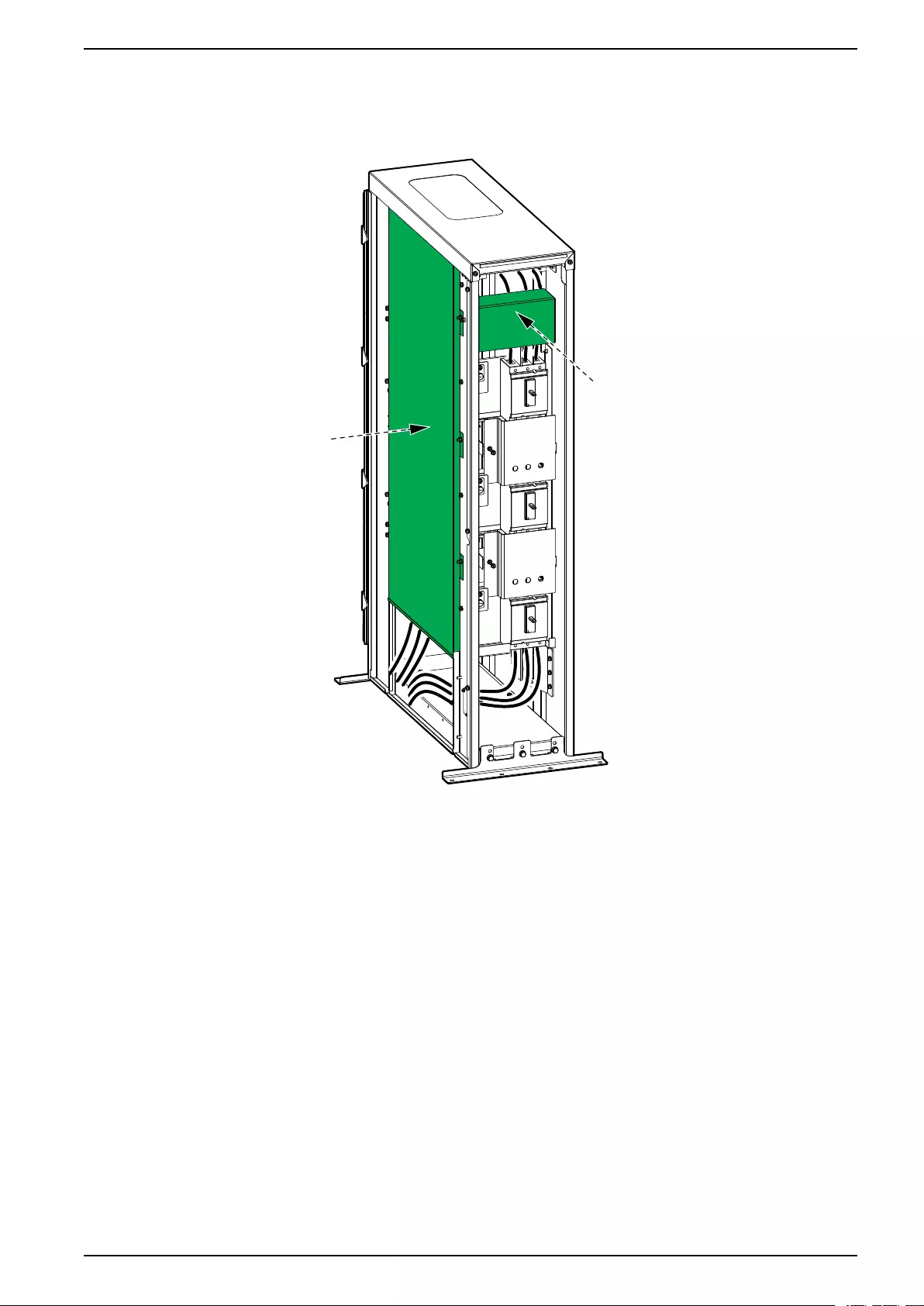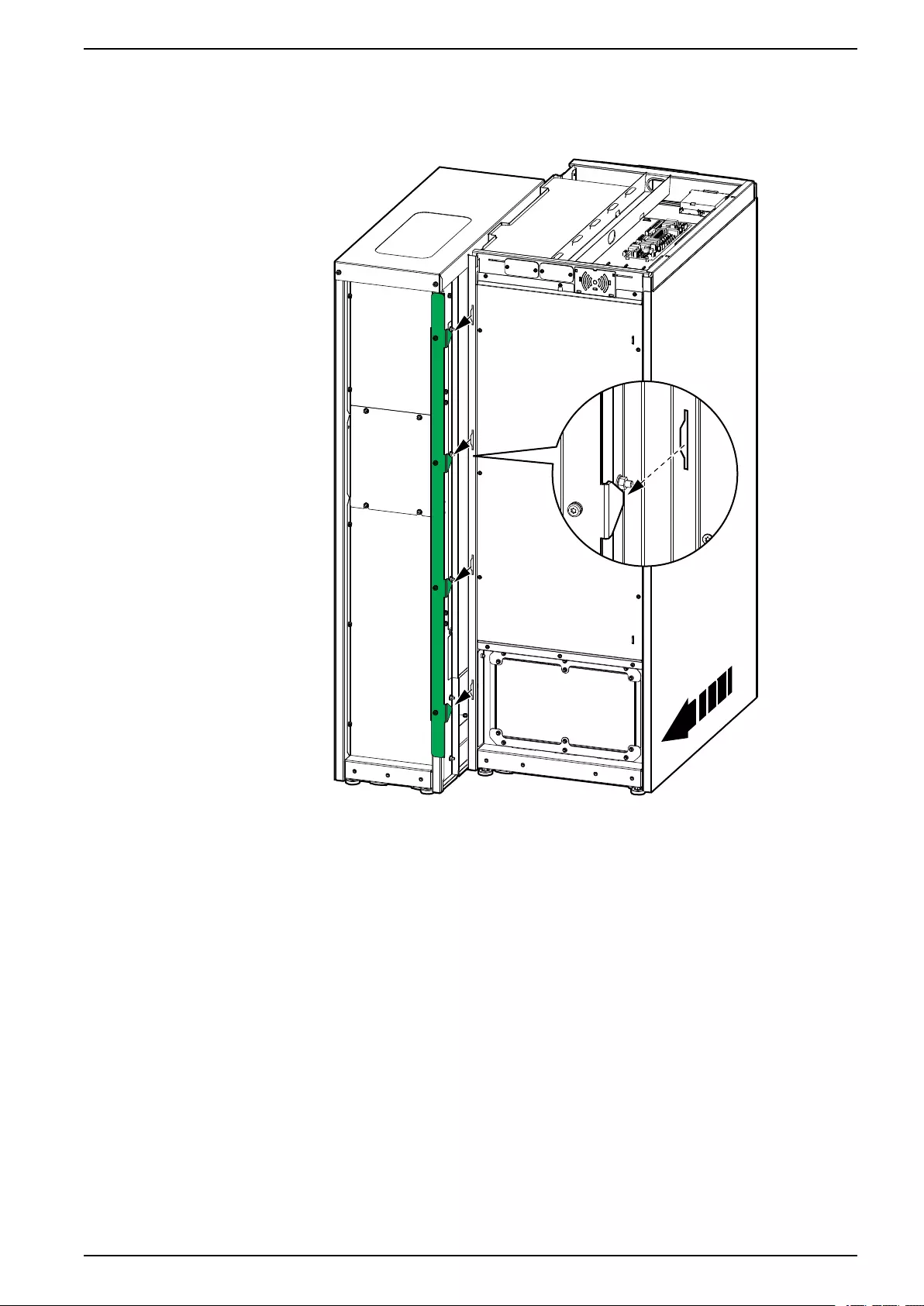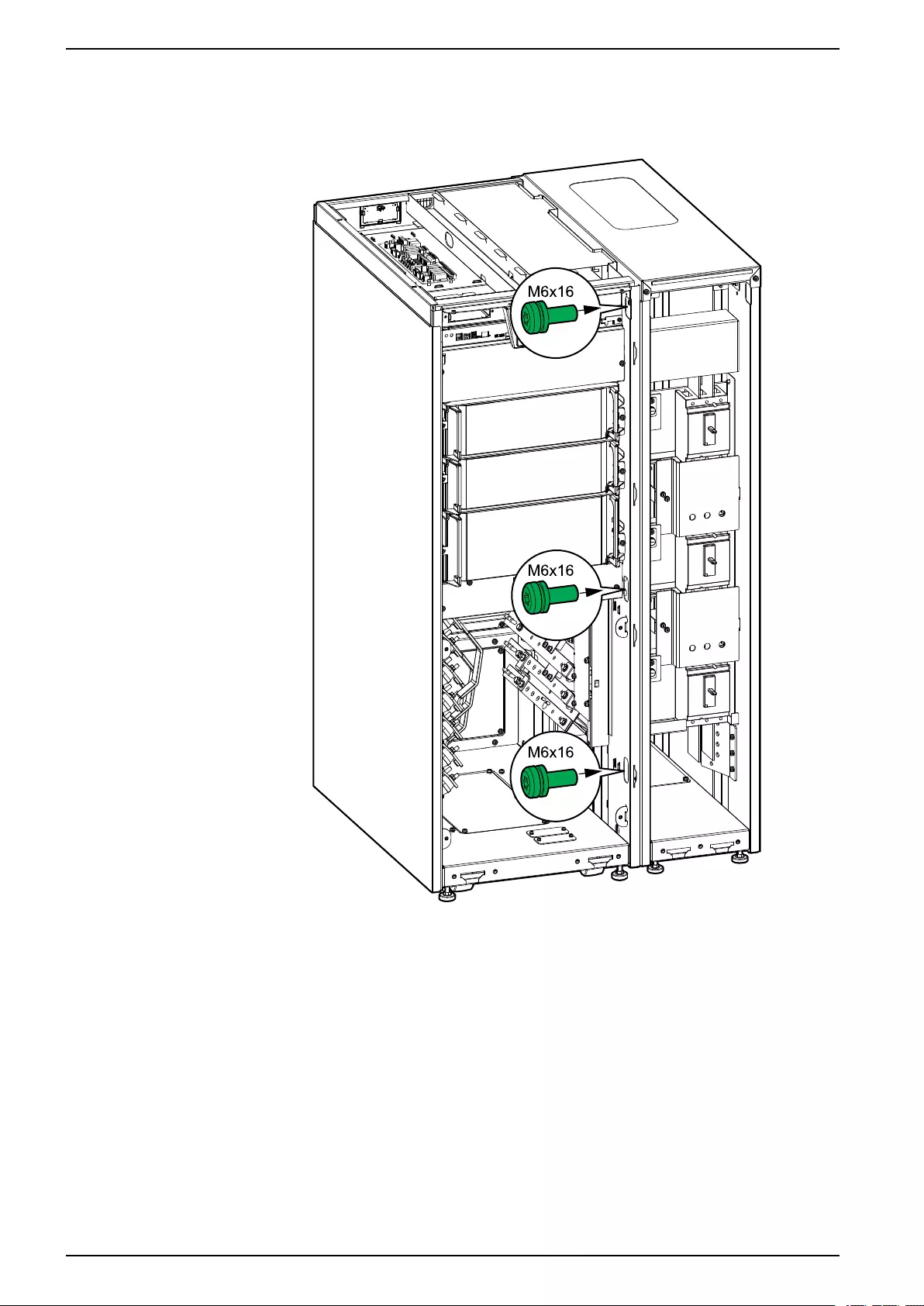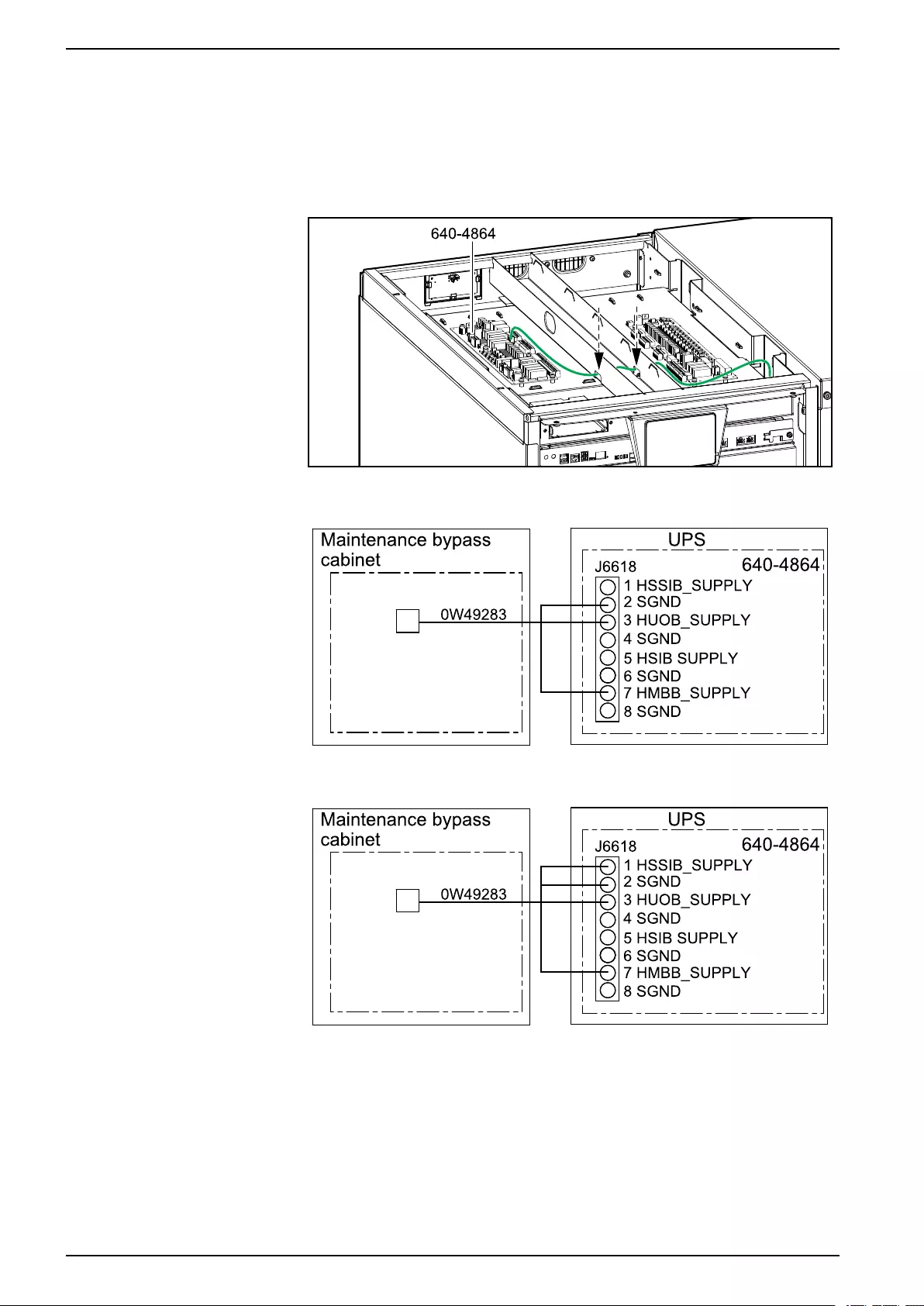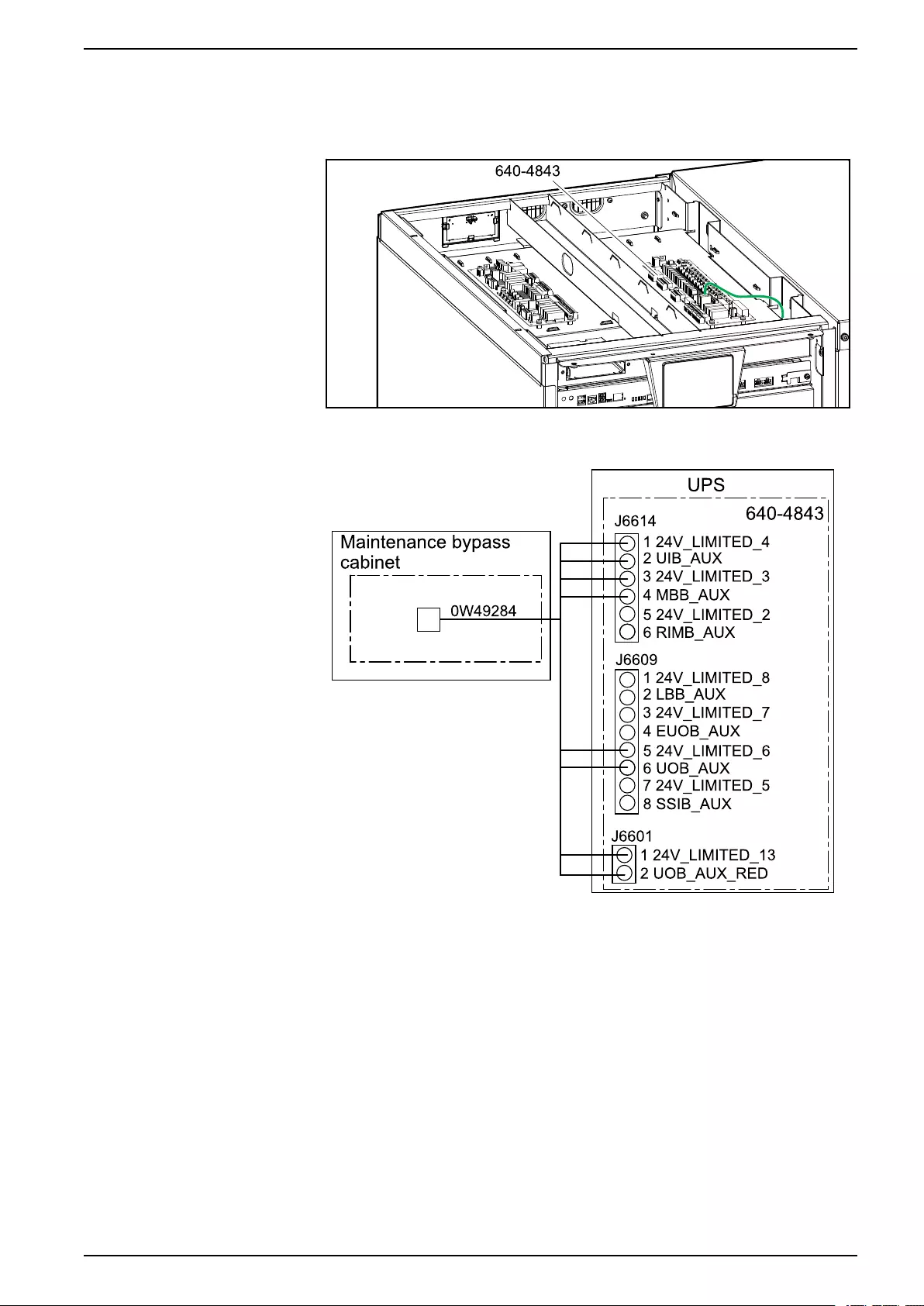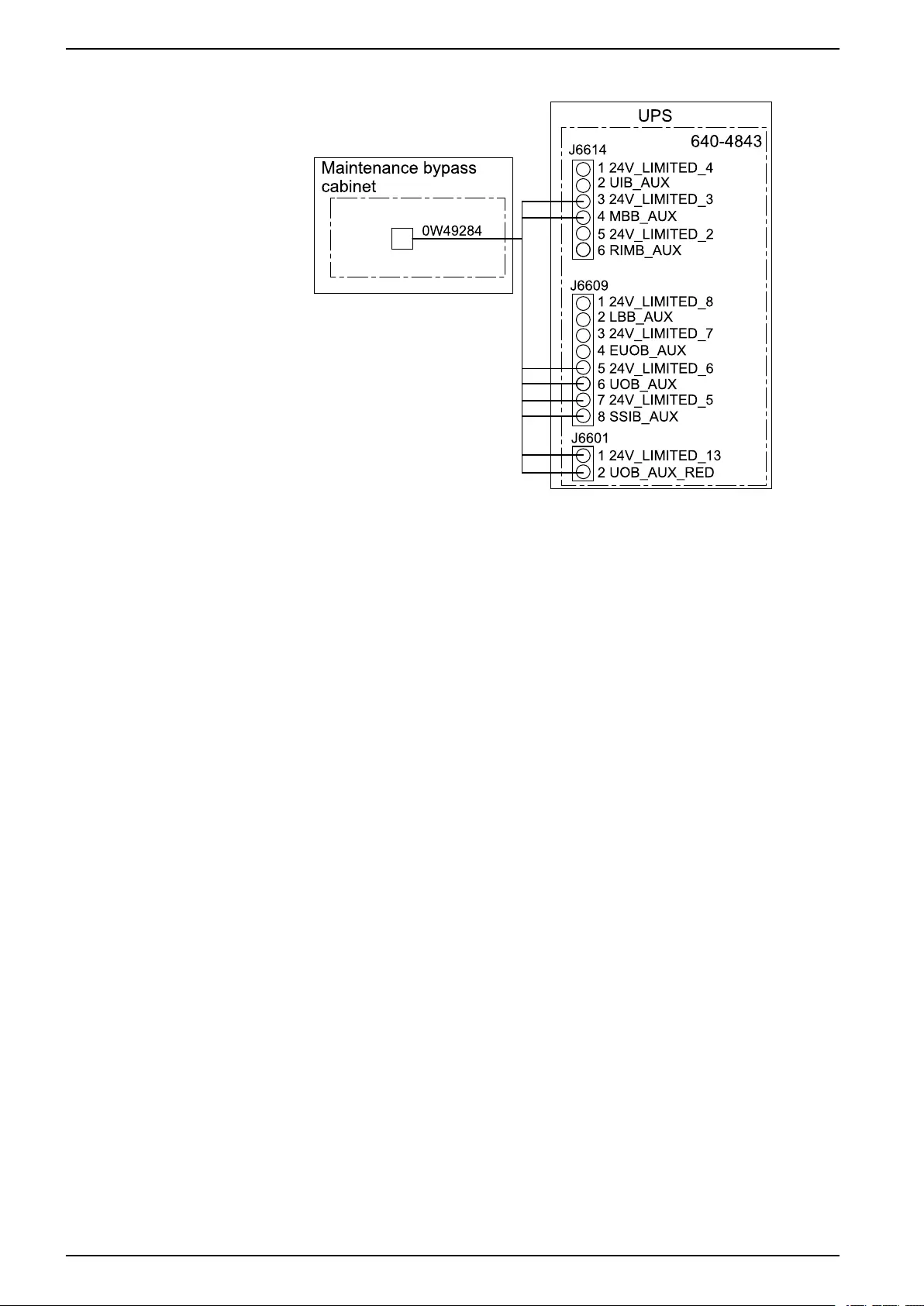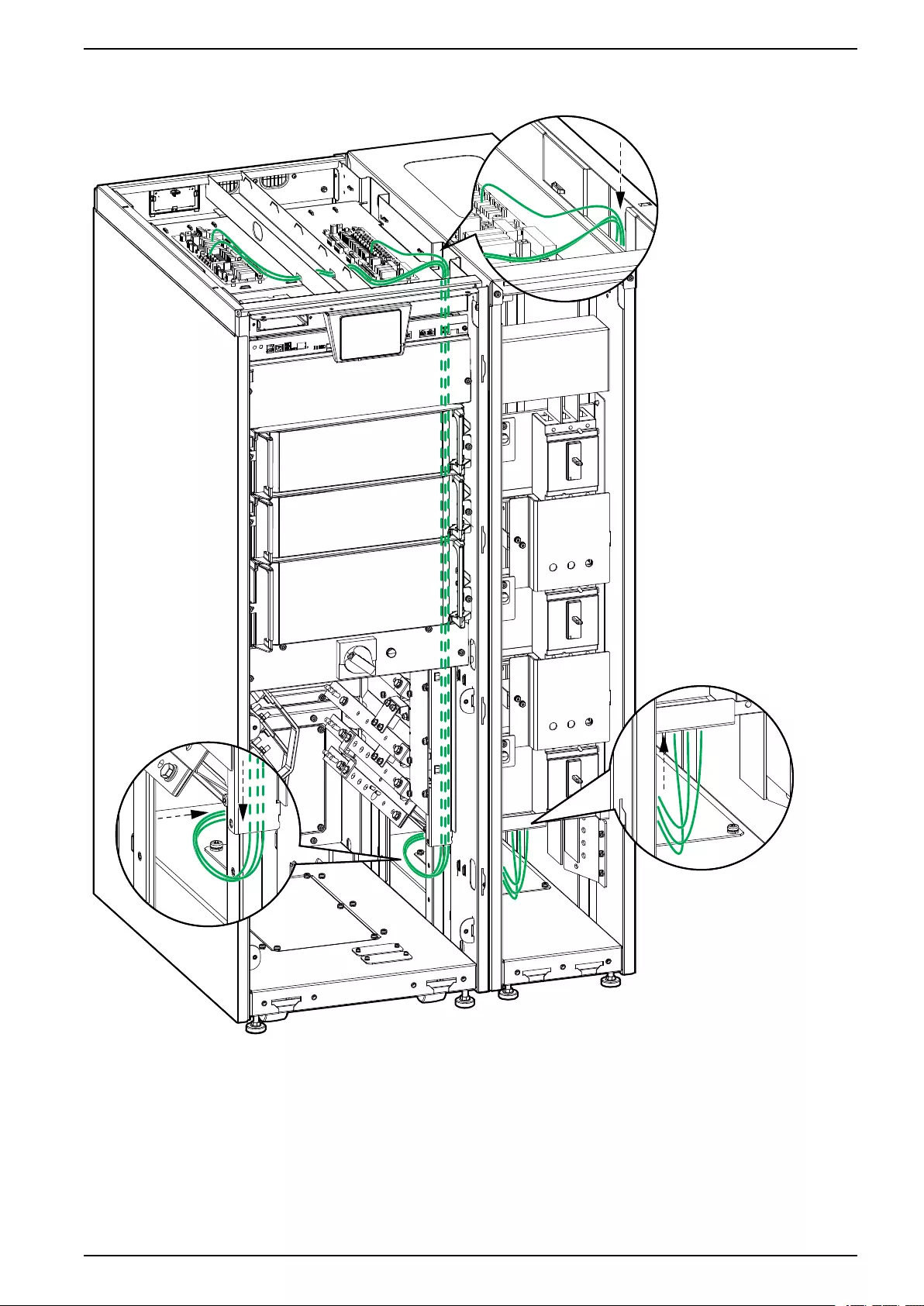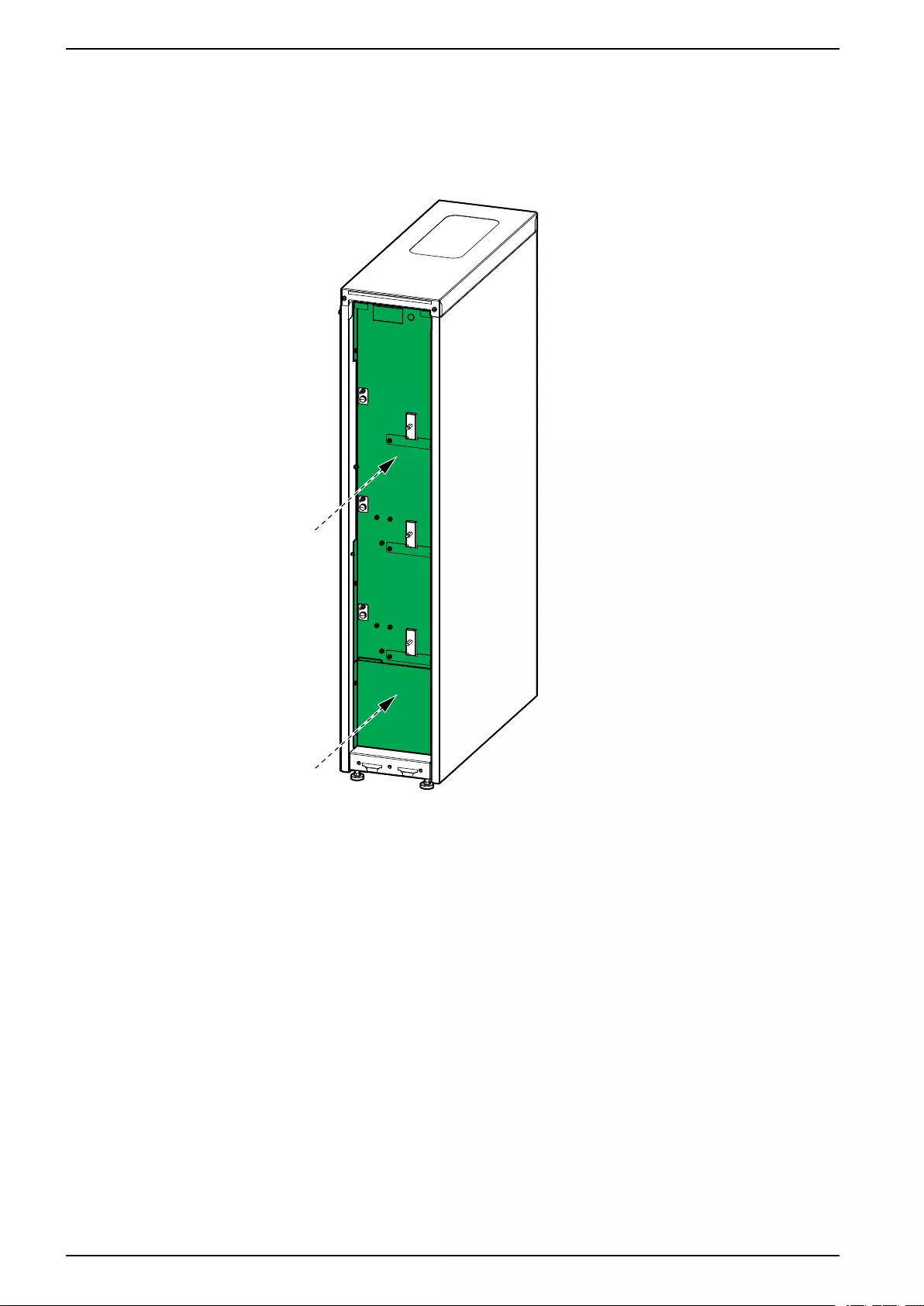Table of Contents
- Important Safety Instructions — SAVE THESE INSTRUCTIONS
- Specifications
- Overview of Installation Kits
- Installation Procedure for Top Cable Entry
- Installation Procedure for Bottom Cable Entry
- Prepare the Maintenance Bypass Cabinet and the UPS for Cables
- Install the Seismic Anchoring (Option)
- Connect the Power Cables in a 10–80 kW Top Cable Entry System
- Connect the Power Cables in a 100–150 kW Top Cable Entry System
- Restrain the Cables
- Connect the Power Cables in a Bottom Cable Entry System
- Connect the Internal Power Cables
- Interconnect the UPS and the Maintenance Bypass Cabinet
- Connect the Signal Cables
- Final Installation
- Blank Page
- Blank Page
APC GVSBPSU80G User Manual
Displayed below is the user manual for GVSBPSU80G by APC which is a product in the UPS Accessories category. This manual has pages.
Related Manuals
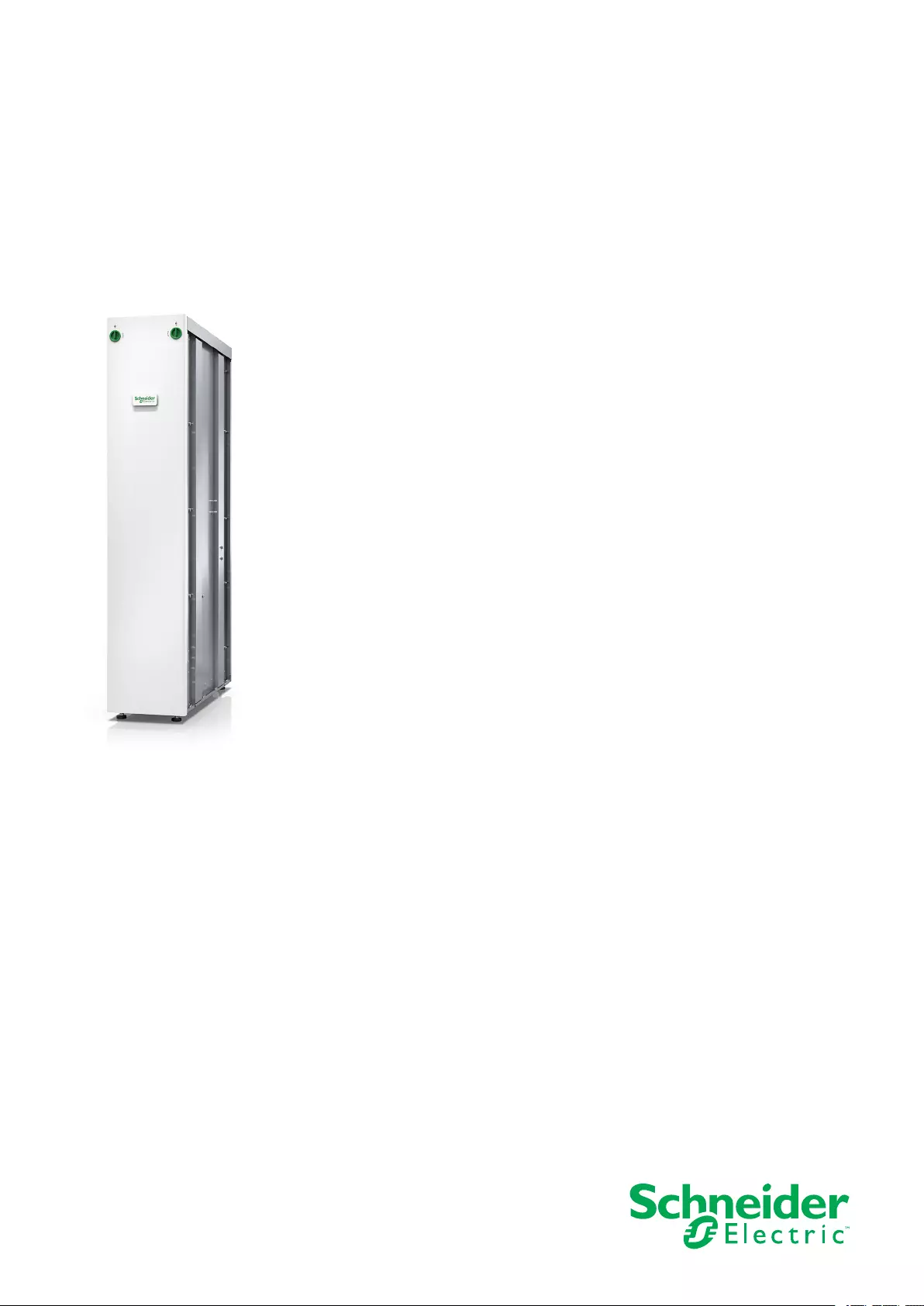
Galaxy VS
Maintenance Bypass Cabinet
Installation
07/2018
www.schneider-electric.com

Legal Information
The Schneider Electric brand and any registered trademarks of Schneider Electric
Industries SAS referred to in this guide are the sole property of Schneider Electric
SA and its subsidiaries. They may not be used for any purpose without the owner's
permission, given in writing. This guide and its content are protected, within the
meaning of the French intellectual property code (Code de la propriété
intellectuelle français, referred to hereafter as "the Code"), under the laws of
copyright covering texts, drawings and models, as well as by trademark law. You
agree not to reproduce, other than for your own personal, noncommercial use as
defined in the Code, all or part of this guide on any medium whatsoever without
Schneider Electric's permission, given in writing. You also agree not to establish
any hypertext links to this guide or its content. Schneider Electric does not grant
any right or license for the personal and noncommercial use of the guide or its
content, except for a non-exclusive license to consult it on an "as is" basis, at your
own risk. All other rights are reserved.
Electrical equipment should be installed, operated, serviced, and maintained only
by qualified personnel. No responsibility is assumed by Schneider Electric for any
consequences arising out of the use of this material.
As standards, specifications, and designs change from time to time, please ask for
confirmation of the information given in this publication.

Maintenance Bypass Cabinet
Table of Contents
Important Safety Instructions — SAVE THESE
INSTRUCTIONS.........................................................................................5
FCC Statement ..........................................................................................6
Safety Precautions .....................................................................................6
Additional Safety Precautions After Installation........................................8
Electrical Safety .........................................................................................8
Battery Safety ............................................................................................9
Specifications ............................................................................................10
Maximum Input Short-Circuit Withstand......................................................10
Specifications for 480 V Systems ............................................................... 10
Trip Settings for 480 V.........................................................................10
Recommended Upstream Protection 480 V ..........................................10
Recommended Cable Sizes 480 V ....................................................... 11
Specifications for 208 V Systems ............................................................... 12
Trip Settings for 200/208/220 V ............................................................12
Recommended Upstream Protection 200/208/220 V .............................12
Recommended Cable Sizes 200/208/220 V ..........................................13
Specifications for 400 V Systems ............................................................... 14
Trip Settings for 400/415 V ..................................................................14
Recommended Upstream Protection 400/415 V ....................................14
Recommended Cable Sizes 400/415 V.................................................15
Recommended Bolt and Lug Sizes ............................................................16
Torque Specifications................................................................................16
Maintenance Bypass Cabinet Weights and Dimensions...............................17
Clearance ................................................................................................17
Environment.............................................................................................17
System Overview .....................................................................................18
Overview of Installation Kits ....................................................................19
Optional Seismic Kit GVSOPT003 .............................................................21
Optional Kirk Key Kit GVSOPT004.............................................................22
Installation Procedure for Top Cable Entry ...........................................23
Installation Procedure for Bottom Cable Entry .....................................24
Prepare the Maintenance Bypass Cabinet and the UPS for
Cables.........................................................................................................25
Install the Seismic Anchoring (Option) ..................................................30
Connect the Power Cables in a 10–80 kW Top Cable Entry
System........................................................................................................32
Connect the Power Cables in a 100–150 kW Top Cable Entry
System........................................................................................................34
Restrain the Cables ..................................................................................36
Connect the Power Cables in a Bottom Cable Entry System.............38
Connect the Internal Power Cables .......................................................39
Interconnect the UPS and the Maintenance Bypass Cabinet ............42
Connect the Signal Cables......................................................................46
Final Installation ........................................................................................50
990-5909-001 3

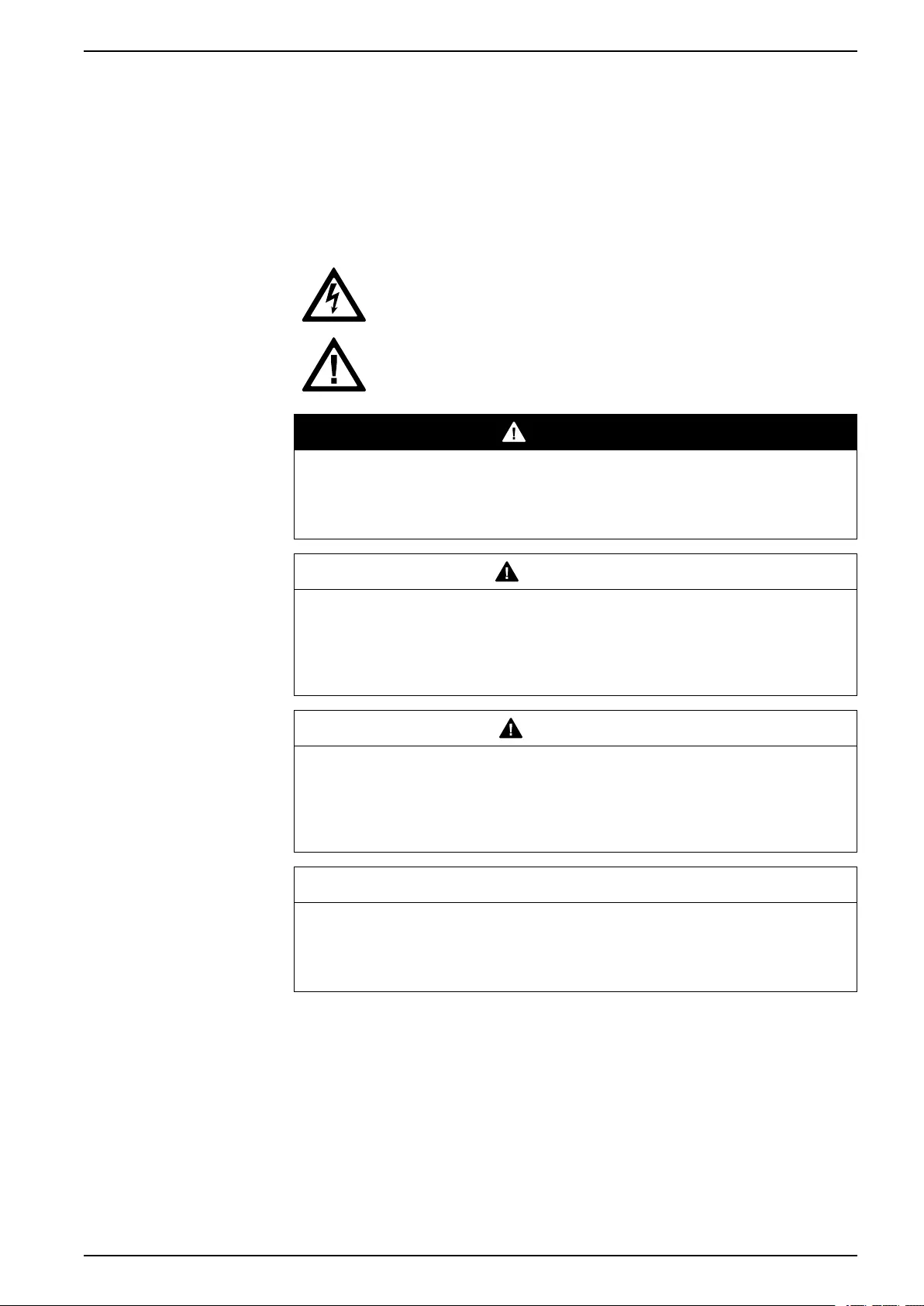
Important Safety Instructions — SAVE THESE
INSTRUCTIONS Maintenance Bypass Cabinet
Important Safety Instructions — SAVE THESE
INSTRUCTIONS
Read these instructions carefully and look at the equipment to become familiar with
it before trying to install, operate, service or maintain it. The following safety
messages may appear throughout this manual or on the equipment to warn of
potential hazards or to call attention to information that clarifies or simplifies a
procedure.
The addition of this symbol to a “Danger” or “Warning” safety
message indicates that an electrical hazard exists which will result in
personal injury if the instructions are not followed.
This is the safety alert symbol. It is used to alert you to potential
personal injury hazards. Obey all safety messages with this symbol
to avoid possible injury or death.
DANGER
DANGER indicates a hazardous situation which, if not avoided, will result in
death or serious injury.
Failure to follow these instructions will result in death or serious injury.
WARNING
WARNING indicates a hazardous situation which, if not avoided, could result in
death or serious injury.
Failure to follow these instructions can result in death, serious injury, or
equipment damage.
CAUTION
CAUTION indicates a hazardous situation which, if not avoided, could result in
minor or moderate injury.
Failure to follow these instructions can result in injury or equipment
damage.
NOTICE
NOTICE is used to address practices not related to physical injury. The safety
alert symbol shall not be used with this type of safety message.
Failure to follow these instructions can result in equipment damage.
Please Note
Electrical equipment should only be installed, operated, serviced, and maintained
by qualified personnel. No responsibility is assumed by Schneider Electric for any
consequences arising out of the use of this material.
A qualified person is one who has skills and knowledge related to the construction,
installation, and operation of electrical equipment and has received safety training
to recognize and avoid the hazards involved.
990-5909-001 5
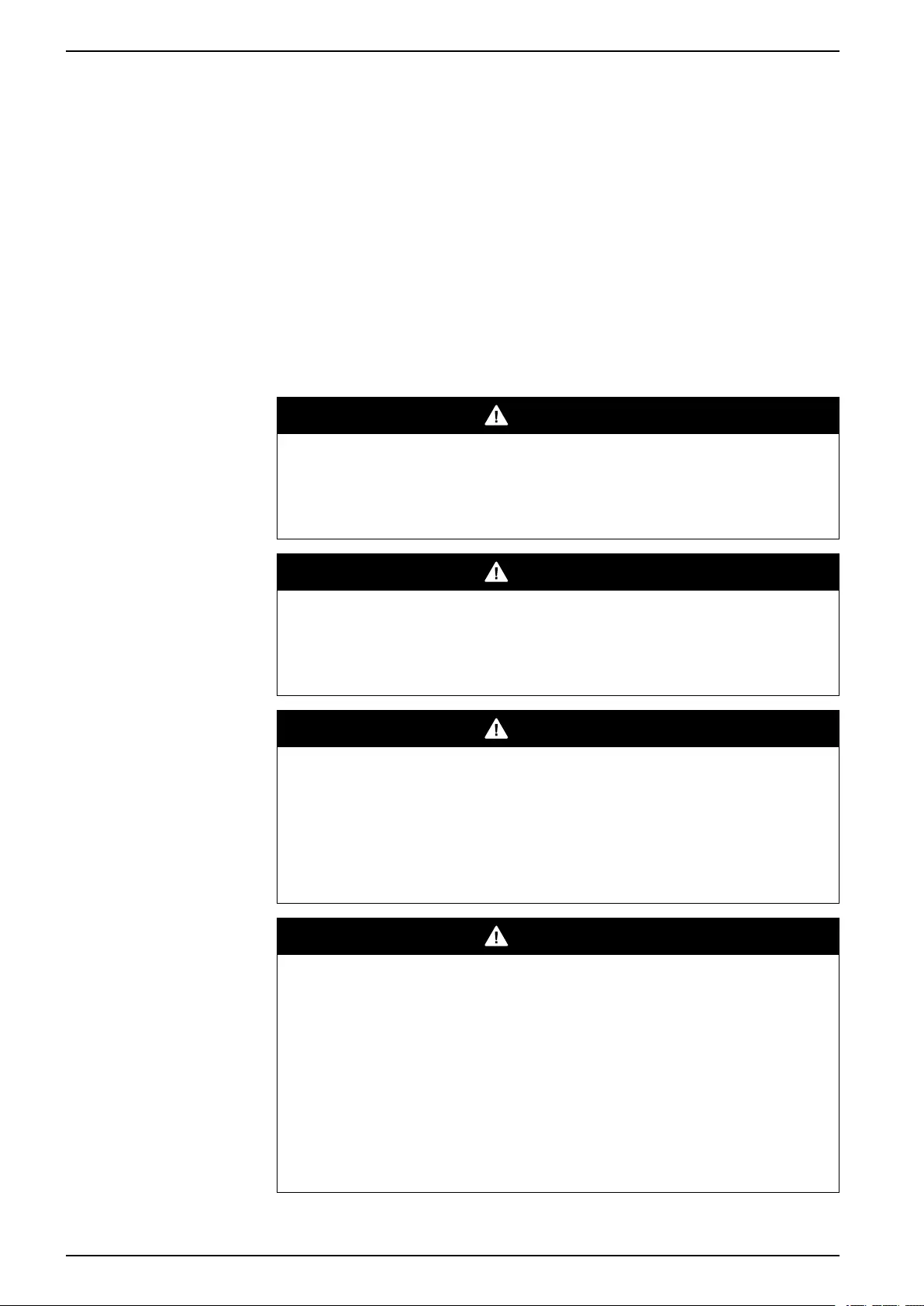
Maintenance Bypass Cabinet
Important Safety Instructions — SAVE THESE
INSTRUCTIONS
FCC Statement
NOTE: This equipment has been tested and found to comply with the limits for
a Class A digital device, pursuant to Part 15 of the FCC Rules. These limits are
designed to provide reasonable protection against harmful interference when
the equipment is operated in a commercial environment. This equipment
generates, uses, and can radiate radio frequency energy and, if not installed
and used in accordance with the instruction manual, may cause harmful
interference to radio communications. Operation of this equipment in a
residential area is likely to cause harmful interference in which case the user
will be required to correct the interference at his own expense.
Any changes or modifications not expressly approved by the party responsible for
compliance could void the user’s authority to operate the equipment.
Safety Precautions
DANGER
HAZARD OF ELECTRIC SHOCK, EXPLOSION, OR ARC FLASH
Read all instructions in the installation manual before installing or working on this
product.
Failure to follow these instructions will result in death or serious injury.
DANGER
HAZARD OF ELECTRIC SHOCK, EXPLOSION, OR ARC FLASH
Do not install the product until all construction work has been completed and the
installation room has been cleaned.
Failure to follow these instructions will result in death or serious injury.
DANGER
HAZARD OF ELECTRIC SHOCK, EXPLOSION, OR ARC FLASH
The product must be installed according to the specifications and requirements
as defined by Schneider Electric. It concerns in particular the external and
internal protections (upstream breakers, battery breakers, cabling, etc.) and
environmental requirements. No responsibility is assumed by Schneider Electric
if these requirements are not respected.
Failure to follow these instructions will result in death or serious injury.
DANGER
HAZARD OF ELECTRIC SHOCK, EXPLOSION, OR ARC FLASH
The UPS system must be installed according to local and national regulations.
Install the UPS according to:
• IEC 60364 (including 60364–4–41- protection against electric shock, 60364–
4–42 - protection against thermal effect, and 60364–4–43 - protection against
overcurrent), or
• NEC NFPA 70, or
• Canadian Electrical Code (C22.1, Part 1)
depending on which one of the standards apply in your local area.
Failure to follow these instructions will result in death or serious injury.
6 990-5909-001
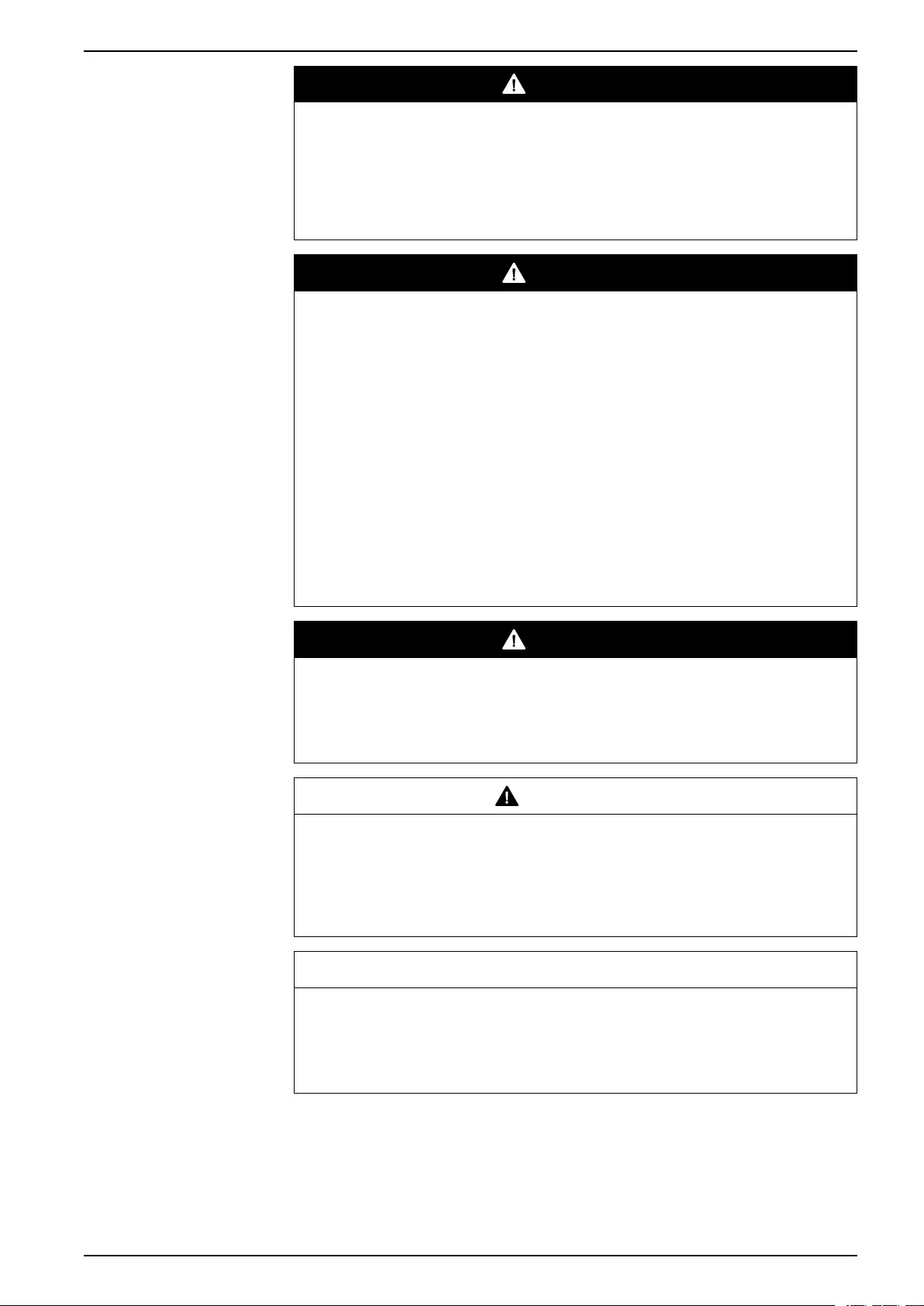
Important Safety Instructions — SAVE THESE
INSTRUCTIONS Maintenance Bypass Cabinet
DANGER
HAZARD OF ELECTRIC SHOCK, EXPLOSION, OR ARC FLASH
• Install the product in a temperature controlled indoor environment free of
conductive contaminants and humidity.
• Install the product on a non-flammable, level and solid surface (e.g. concrete)
that can support the weight of the system.
Failure to follow these instructions will result in death or serious injury.
DANGER
HAZARD OF ELECTRIC SHOCK, EXPLOSION, OR ARC FLASH
The product is not designed for and must therefore not be installed in the
following unusual operating environments:
• Damaging fumes
• Explosive mixtures of dust or gases, corrosive gases, or conductive or radiant
heat from other sources
• Moisture, abrasive dust, steam or in an excessively damp environment
• Fungus, insects, vermin
• Salt-laden air or contaminated cooling refrigerant
• Pollution degree higher than 2 according to IEC 60664-1
• Exposure to abnormal vibrations, shocks, and tilting
• Exposure to direct sunlight, heat sources, or strong electromagnetic fields
Failure to follow these instructions will result in death or serious injury.
DANGER
HAZARD OF ELECTRIC SHOCK, EXPLOSION, OR ARC FLASH
Do not drill or cut holes for cables or conduits with the gland plates installed and
do not drill or cut holes in close proximity to the UPS.
Failure to follow these instructions will result in death or serious injury.
WARNING
HAZARD OF ARC FLASH
Do not make mechanical changes to the product (including removal of cabinet
parts or drilling/cutting of holes) that are not described in the installation manual.
Failure to follow these instructions can result in death, serious injury, or
equipment damage.
NOTICE
RISK OF OVERHEATING
Respect the space requirements around the product and do not cover the
ventilation openings when the product is in operation.
Failure to follow these instructions can result in equipment damage.
990-5909-001 7
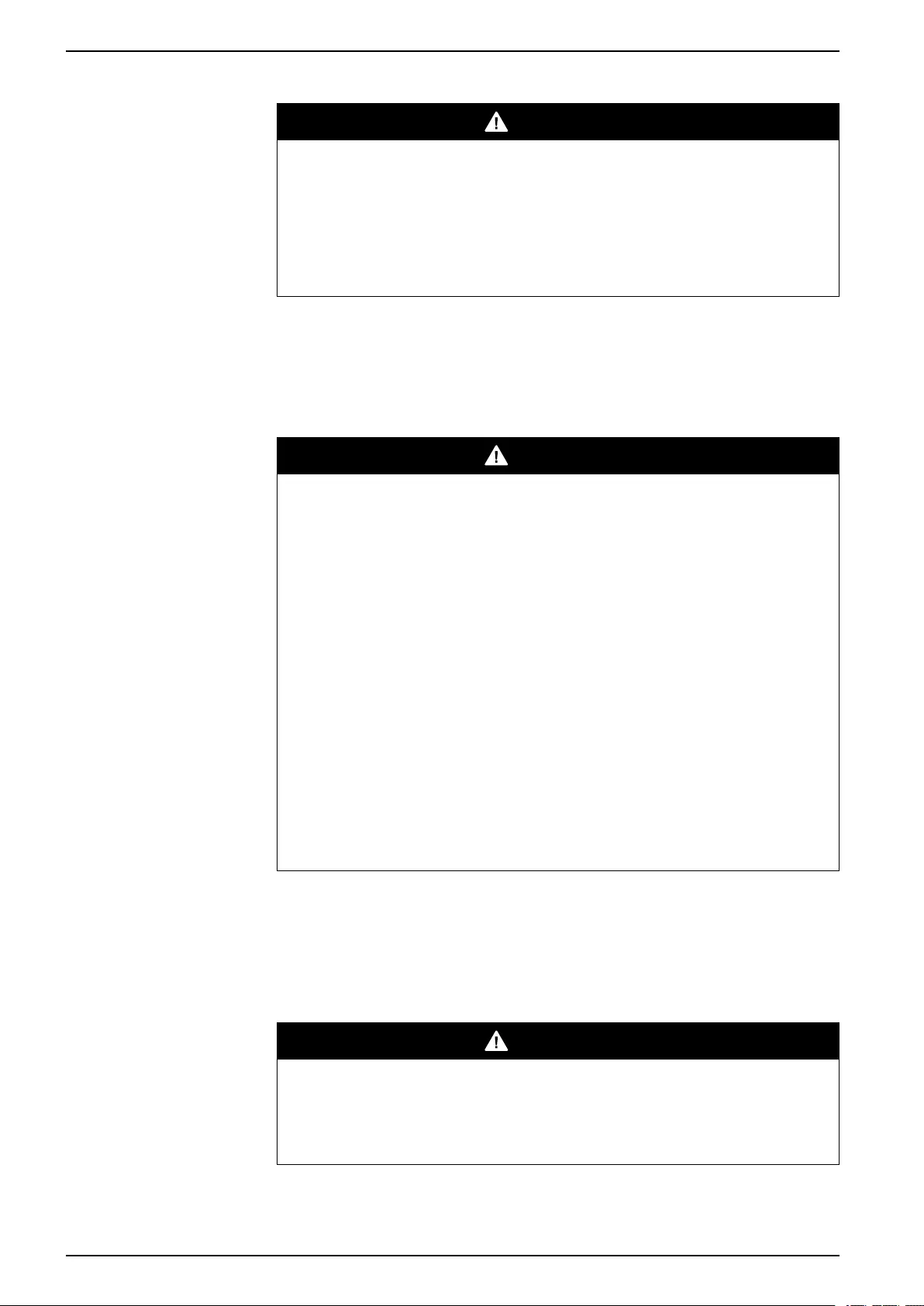
Maintenance Bypass Cabinet
Important Safety Instructions — SAVE THESE
INSTRUCTIONS
Additional Safety Precautions After Installation
DANGER
HAZARD OF ELECTRIC SHOCK, EXPLOSION, OR ARC FLASH
Do not install the UPS system until all construction work has been completed
and the installation room has been cleaned. If additional construction work is
needed in the installation room after this product has been installed, turn off the
product and cover the product with the protective packaging bag the product was
delivered in.
Failure to follow these instructions will result in death or serious injury.
Electrical Safety
This manual contains important safety instructions that should be followed during
the installation and maintenance of the UPS system.
DANGER
HAZARD OF ELECTRIC SHOCK, EXPLOSION, OR ARC FLASH
• Electrical equipment must be installed, operated, serviced, and maintained
only by qualified personnel.
• Apply appropriate personal protective equipment (PPE) and follow safe
electrical work practices.
• Disconnection devices for AC and DC must be provided by others, be readily
accessible, and the function of the disconnect device marked for its function.
• Turn off all power supplying the UPS system before working on or inside the
equipment.
• Before working on the UPS system, check for hazardous voltage between all
terminals including the protective earth.
• The UPS contains an internal energy source. Hazardous voltage can be
present even when disconnected from the mains supply. Before installing or
servicing the UPS system, ensure that the units are OFF and that mains and
batteries are disconnected. Wait five minutes before opening the UPS to
allow the capacitors to discharge.
• The UPS must be properly earthed/grounded and due to a high leakage
current, the earthing/grounding conductor must be connected first.
Failure to follow these instructions will result in death or serious injury.
When the UPS input is connected through external isolators that, when opened,
isolate the neutral or when the automatic backfeed isolation is provided external to
the equipment or is connected to an IT power distribution system, a label must be
fitted at the UPS input terminals, and on all primary power isolators installed
remotely from the UPS area and on external access points between such isolators
and the UPS, by the user, displaying the following text (or equivalent in a language
which is acceptable in the country in which the UPS system is installed):
DANGER
HAZARD OF ELECTRIC SHOCK, EXPLOSION, OR ARC FLASH
Risk of voltage backfeed. Before working on this circuit: Isolate the UPS and
check for hazardous voltage between all terminals including the protective earth.
Failure to follow these instructions will result in death or serious injury.
8 990-5909-001
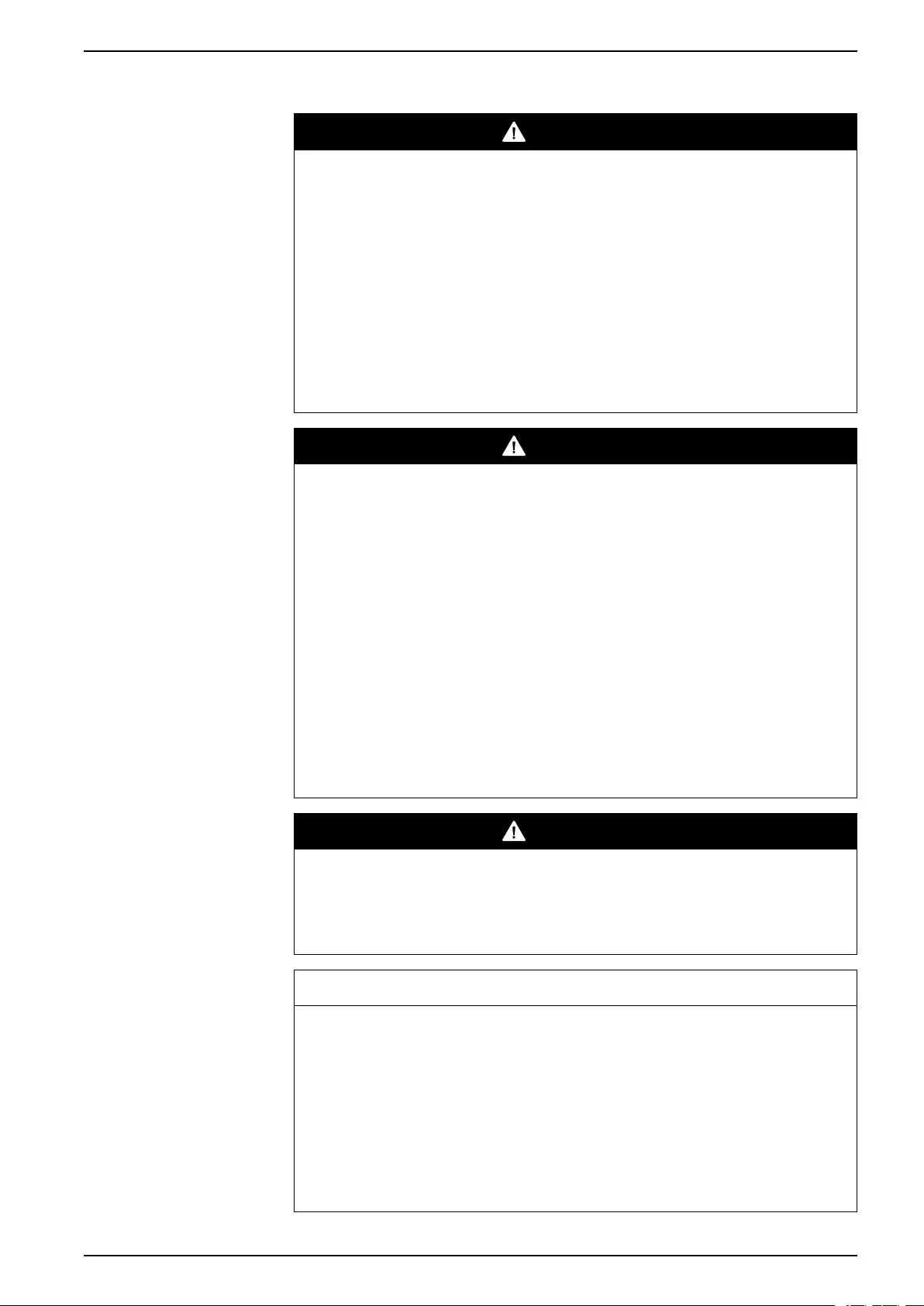
Important Safety Instructions — SAVE THESE
INSTRUCTIONS Maintenance Bypass Cabinet
Battery Safety
DANGER
HAZARD OF ELECTRIC SHOCK, EXPLOSION, OR ARC FLASH
• Battery circuit breakers must be installed according to the specifications and
requirements as defined by Schneider Electric.
• Servicing of batteries must only be performed or supervised by qualified
personnel knowledgeable of batteries and the required precautions. Keep
unqualified personnel away from batteries.
• Disconnect charging source prior to connecting or disconnecting battery
terminals.
• Do not dispose of batteries in a fire as they can explode.
• Do not open, alter, or mutilate batteries. Released electrolyte is harmful to the
skin and eyes. It may be toxic.
Failure to follow these instructions will result in death or serious injury.
DANGER
HAZARD OF ELECTRIC SHOCK, EXPLOSION, OR ARC FLASH
Batteries can present a risk of electric shock and high short-circuit current. The
following precautions must be observed when working on batteries
• Remove watches, rings, or other metal objects.
• Use tools with insulated handles.
• Wear protective glasses, gloves and boots.
• Do not lay tools or metal parts on top of batteries.
• Disconnect the charging source prior to connecting or disconnecting battery
terminals.
• Determine if the battery is inadvertently grounded. If inadvertently grounded,
remove source from ground. Contact with any part of a grounded battery can
result in electric shock. The likelihood of such shock can be reduced if such
grounds are removed during installation and maintenance (applicable to
equipment and remote battery supplies not having a grounded supply circuit).
Failure to follow these instructions will result in death or serious injury.
DANGER
HAZARD OF ELECTRIC SHOCK, EXPLOSION, OR ARC FLASH
When replacing batteries, always replace with the same type and number of
batteries or battery packs.
Failure to follow these instructions will result in death or serious injury.
NOTICE
RISK OF EQUIPMENT DAMAGE
• Wait until the system is ready to be powered up before installing batteries in
the system. The time duration from battery installation until the UPS system
is powered up must not exceed 72 hours or 3 days.
• Batteries must not be stored more than six months due to the requirement of
recharging. If the UPS system remains de-energized for a long period,
Schneider Electric recommends that you energize the UPS system for a
period of 24 hours at least once every month. This charges the batteries, thus
avoiding irreversible damage.
Failure to follow these instructions can result in equipment damage.
990-5909-001 9
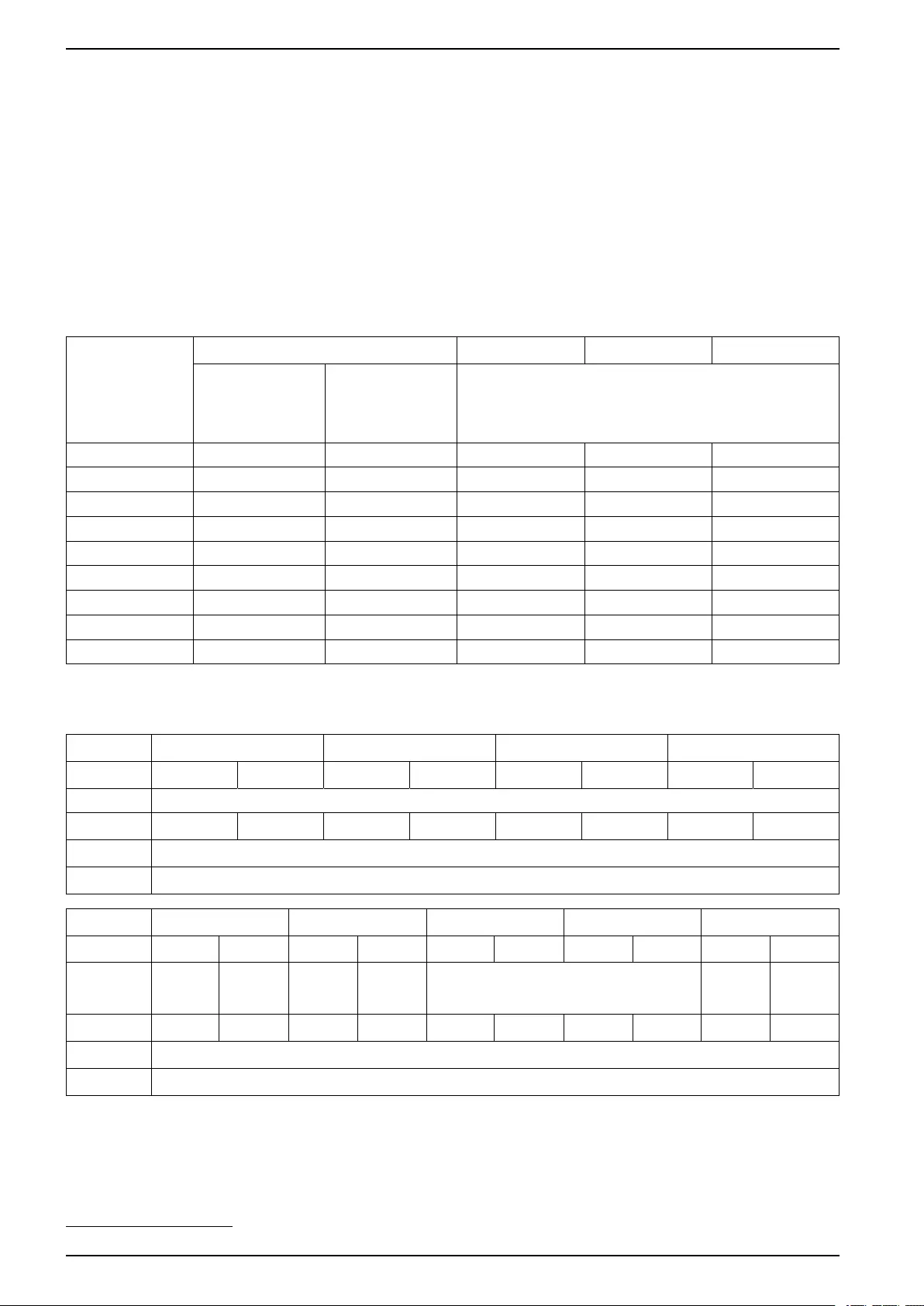
Maintenance Bypass Cabinet Specifications
Specifications
Maximum Input Short-Circuit Withstand
The maximum input short-circuit withstand for the maintenance bypass cabinet is
Icw 65 kA RMS symmetrical.
Specifications for 480 V Systems
Trip Settings for 480 V
Rating (kW) Breaker Ir tr at 6 Ir1li (x In)1
Unit input breaker
UIB /
Static switch input
breaker SSIB
Maintenance
bypass breaker
MBB /
Unit output breaker
UOB
All breakers
20 HJF36150CU31X HJF36150CU31X 50 0.5 1.5
30 HJF36150CU31X HJF36150CU31X 50 0.5 1.5
40 HJF36150CU31X HJF36150CU31X 70 0.5 1.5
50 HJF36150CU31X HJF36150CU31X 80 0.5 1.5
60 HJF36150CU31X HJF36150CU31X 100 0.5 1.5
80 HJF36150CU31X HJF36150CU31X 125 0.5 1.5
100 LJF36400CU31X JJF36250CU31X 175 0.5 1.5
120 LJF36400CU31X JJF36250CU31X 200 0.5 1.5
150 LJF36400CU31X JJF36250CU31X 250 0.5 1.5
Recommended Upstream Protection 480 V
Rating 20 kW 30 kW 40 kW 50 kW
Input Bypass Input Bypass Input Bypass Input Bypass
Breaker HJF36100CU31X
Ir (A) 40 35 60 50 80 70 100 80
Tr at 6 Ir (A) 0.5
li (x In) (A) 1.5
Rating 60 kW 80 kW 100 kW 120 kW 150 kW
Input Bypass Input Bypass Input Bypass Input Bypass Input Bypass
Breaker HJ-
F36150-
CU31X
HJ-
F36100-
CU31X
JJ-
F36250-
CU31X
HJ-
F36150-
CU31X
JJF36250CU31X LJ-
F36400-
CU31X
JJ-
F36250-
CU31X
Ir (A) 125 100 175 125 200 175 250 200 300 250
Tr at 6 Ir (A) 0.5
li (x In) (A) 1.5
10 990-5909-001
1. tr and li must be set during installation. The default setting is marked on the breaker.
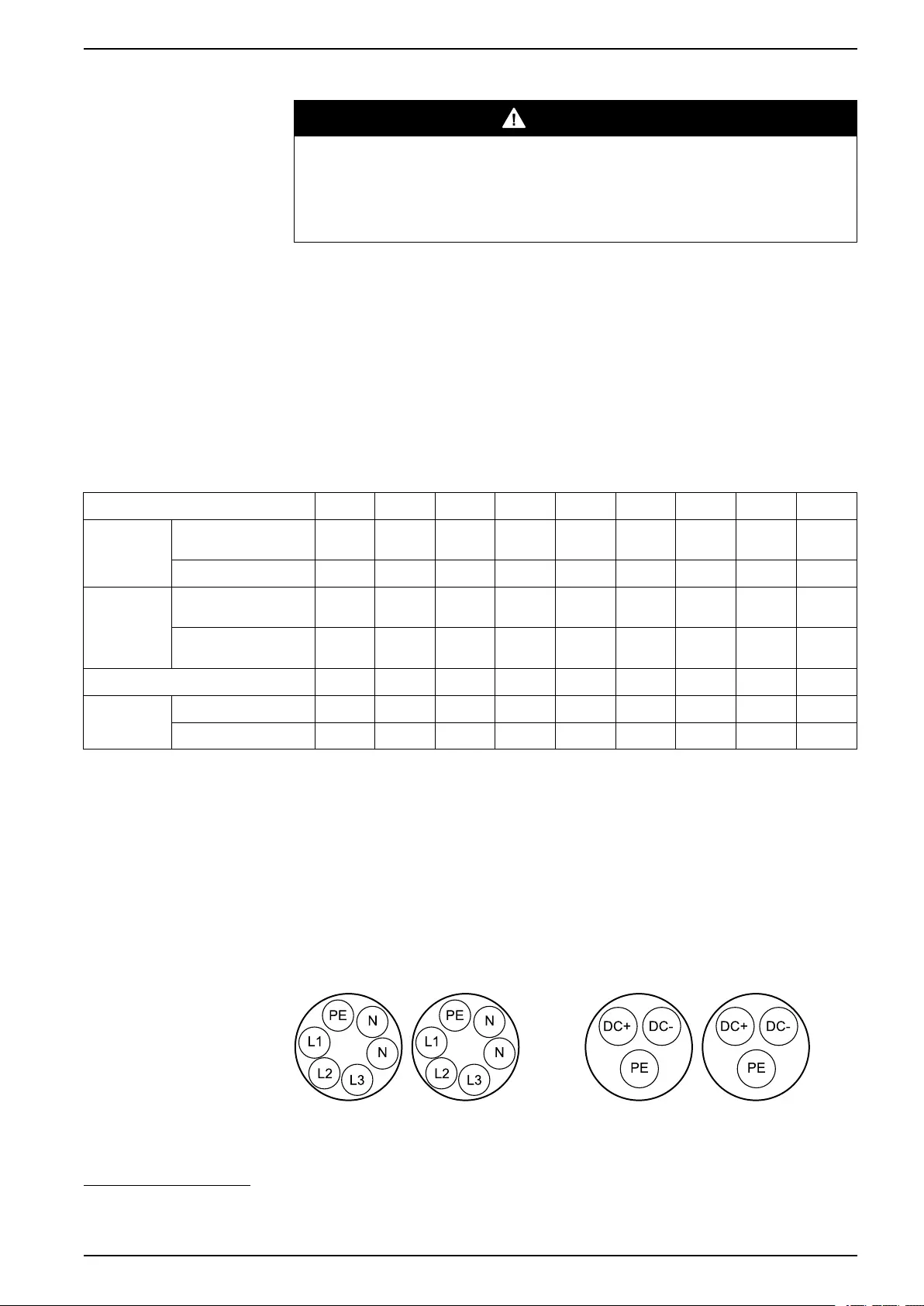
Specifications Maintenance Bypass Cabinet
Recommended Cable Sizes 480 V
DANGER
HAZARD OF ELECTRIC SHOCK, EXPLOSION, OR ARC FLASH
All wiring must comply with all applicable national and/or electrical codes. The
maximum allowable cable size is 4/0 AWG.
Failure to follow these instructions will result in death or serious injury.
NOTE: Overcurrent protection is to be provided by others.
Cable sizes in this manual are based on Table 310.15 (B)(16) of the National
Electrical Code (NEC) with the following assertions:
• 90 °C (194 °F) conductors (75 °C (167 °F) termination)
• An ambient temperature of 30 °C (86 °F)
• Use of copper conductors
If the ambient temperature is greater than 30 °C (86 °F), larger conductors are to
be selected in accordance with the correction factors of the NEC.
Equipment grounding conductors (PE in this manual) are sized in accordance with
NEC Article 250.122 and Table 250.122.
Copper 20 kW 30 kW 40 kW 50 kW 60 kW 80 kW 100 kW 120 kW 150 kW
Input Input phases (AWG/
kcmil)
8 6 4 3 1 2/0 2 x 1/0 2 x 1/0 2 x 1/0
Input PE (AWG/kcmil) 10 8 8 6 6 6 4 2 x 4 2 x 3
Bypass/
Output
Bypass/output phases
(AWG/kcmil)
10 8 6 4 3 1 2/0 2 x 1/0 2 x 1/0
Bypass PE/output PE
(AWG/kcmil)
10 10 8 8 8 6 6 2 x 6 2 x 4
Neutral (AWG/kcmil)26 4 2 1/0 2/0 2 x 1/0 2 x 1/0 4 x 1/0 4 x 1/0
DC DC +/- (AWG/kcmil) 43231/031/042/044/042 x 1/042 x 3/0 2 x 4/0
DC PE (AWG/kcmil) 8 6 6 6 6 4 4 3 2 x 2
NOTE: The DC cable sizes given here are recommendations — Always follow
the specific instructions in the battery solution documentation for DC +/- and
DC PE cable sizes.
NOTE: For 120 kW, use two separate conduits for each of the input, bypass,
and output cable sets. Organize cables as illustrated in each conduit to avoid
eddy currents (heating).
NOTE: For 150 kW, use two separate conduits for each of the input, bypass,
output, and DC cable sets. Organize cables as illustrated in each conduit to
avoid eddy currents (heating).
Cable Organization in Separate Conduits for Input/Bypass/Output and DC
990-5909-001 11
2. Neutral conductor is sized to handle 1.73 times phase current in case of high harmonic content from non-linear loads. If low or no
harmonic currents are expected, neutral conductor can be sized as phase conductor.
3. 20-40 kW: battery cables are sized according to 32 blocks.
4. 50 kW and higher: battery cables are sized according to 40 blocks.
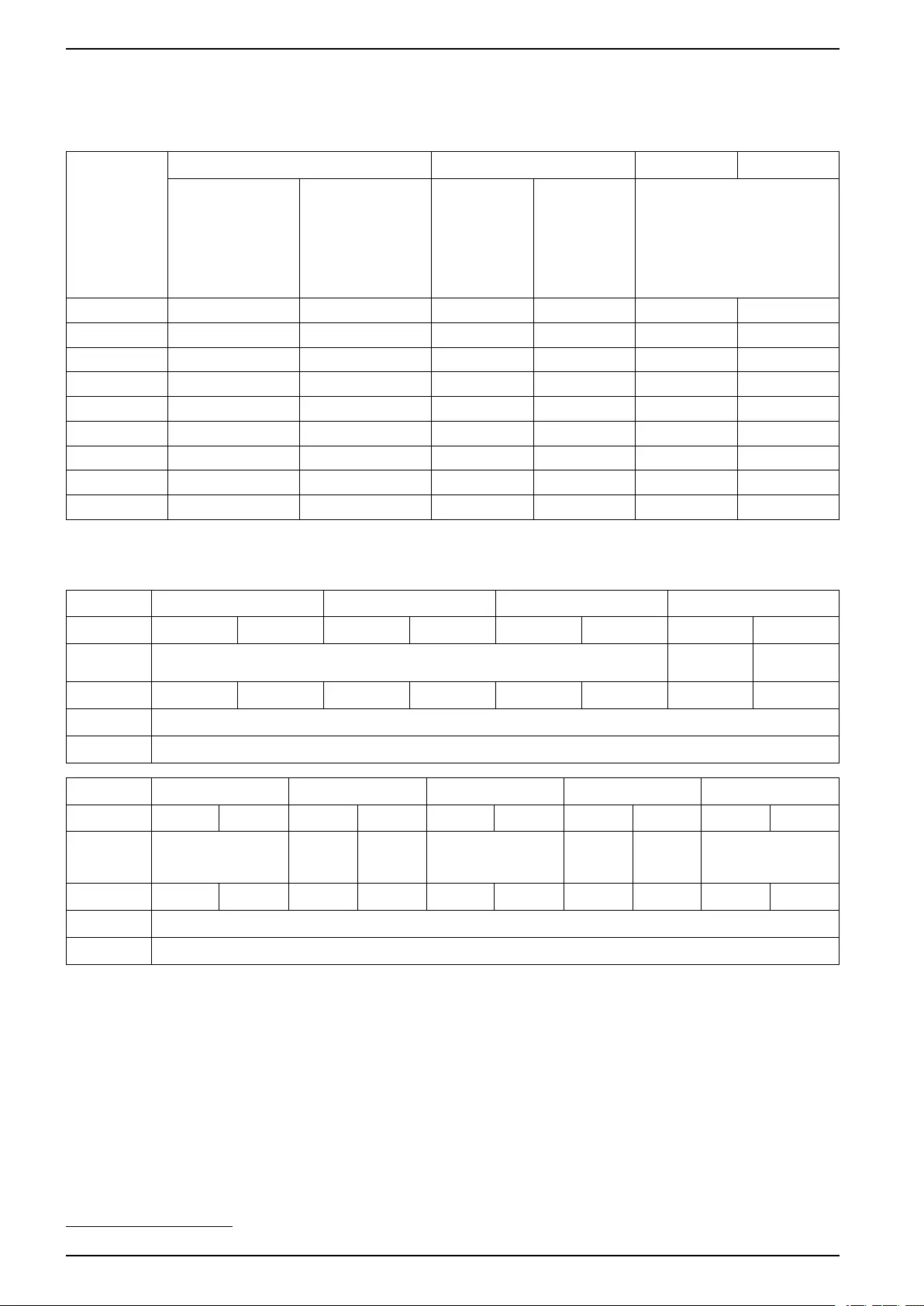
Maintenance Bypass Cabinet Specifications
Specifications for 208 V Systems
Trip Settings for 200/208/220 V
Rating (kW) Breaker Ir tr at 6 Ir5li (x In)5
Unit input breaker
UIB /
Static switch input
breaker SSIB
Maintenance
bypass breaker
MBB /
Unit output breaker
UOB
Unit input
breaker UIB
Static switch
input breaker
SSIB /
Maintenance
bypass
breaker MBB /
Unit output
breaker UOB
All breakers
10 HJF36150CU31X HJF36150CU31X 50 50 0.5 1.5
15 HJF36150CU31X HJF36150CU31X 60 60 0.5 1.5
20 HJF36150CU31X HJF36150CU31X 80 80 0.5 1.5
25 HJF36150CU31X HJF36150CU31X 100 100 0.5 1.5
30 HJF36150CU31X HJF36150CU31X 125 110 0.5 1.5
40 HJF36150CU31X HJF36150CU31X 150 150 0.5 1.5
50 LJF36400CU31X JJF36250CU31X 200 200 0.5 1.5
60 LJF36400CU31X JJF36250CU31X 250 225 0.5 1.5
75 LJF36400CU31X JJF36250CU31X 300 250 0.5 1.5
Recommended Upstream Protection 200/208/220 V
Rating 10 kW 15 kW 20 kW 25 kW
Input Bypass Input Bypass Input Bypass Input Bypass
Breaker HJF36100CU31X HJF36150C-
U31X
HJF36100C-
U31X
Ir (A) 50 40 80 60 100 80 125 100
tr at 6 Ir (A) 0.5
li (x In) (A) 1.5
Rating 30 kW 40 kW 50 kW 60 kW 75 kW
Input Bypass Input Bypass Input Bypass Input Bypass Input Bypass
Breaker HJF36150CU31X JJ-
F36250-
CU31X
HJ-
F36150-
CU31X
JJF36250CU31X LJ-
F36400-
CU31X
JJ-
F36250-
CU31X
LJF36400CU31X
Ir (A) 150 110 200 150 250 200 300 225 350 300
tr at 6 Ir (A) 0.5
li (x In) (A) 1.5
12 990-5909-001
5. tr and li must be set during installation. The default setting is marked on the breaker.
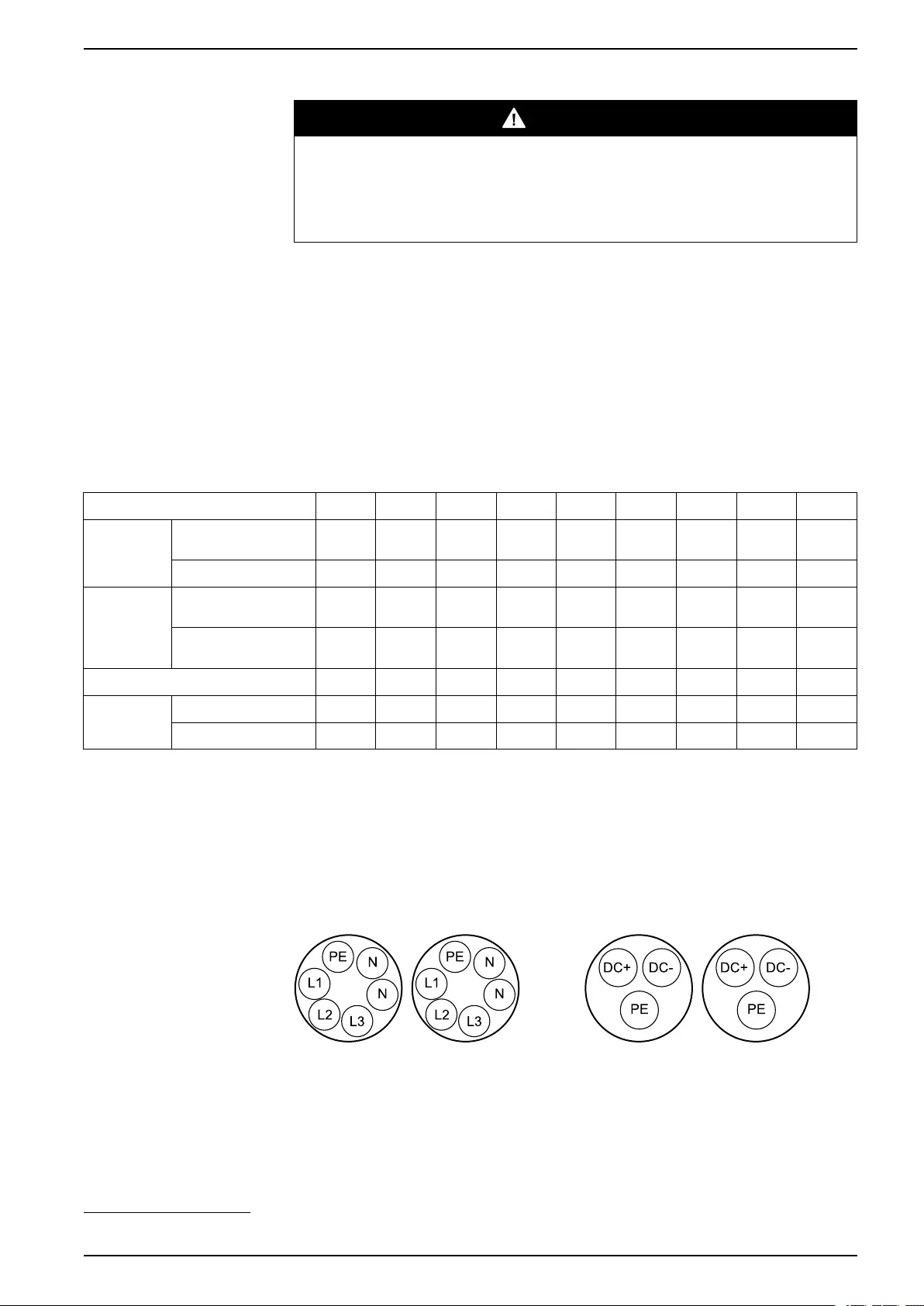
Specifications Maintenance Bypass Cabinet
Recommended Cable Sizes 200/208/220 V
DANGER
HAZARD OF ELECTRIC SHOCK, EXPLOSION, OR ARC FLASH
All wiring must comply with all applicable national and/or electrical codes. The
maximum allowable cable size is 4/0 AWG.
Failure to follow these instructions will result in death or serious injury.
NOTE: Overcurrent protection is to be provided by others.
Cable sizes in this manual are based on Table 310.15 (B)(16) of the National
Electrical Code (NEC) with the following assertions:
• 90 °C (194 °F) conductors (75 °C (167 °F) termination)
• An ambient temperature of 30 °C (86 °F)
• Use of copper conductors
If the ambient temperature is greater than 30 °C (86 °F), larger conductors are to
be selected in accordance with the correction factors of the NEC.
Equipment grounding conductors (PE in this manual) are sized in accordance with
NEC Article 250.122 and Table 250.122.
Copper 10 kW 15 kW 20 kW 25 kW 30 kW 40 kW 50 kW 60 kW 75 kW
Input Input phases (AWG/
kcmil)
8 4 3 2 1/0 2 x 1/0 2 x 1/0 2 x 1/0 2 x 2/0
Input PE (AWG/kcmil) 10 8 8 6 6 6 2 x 4 2 x 4 2 x 3
Bypass/
output
Bypass/output phases
(AWG/kcmil)
8 6 4 3 2 1/0 2 x 1/0 2 x 1/0 2 x 1/0
Bypass PE/output PE
(AWG/kcmil)
10 10 8 8 6 6 2 x 6 2 x 4 2 x 4
Neutral (AWG/kcmil)66 3 1 2/0 2 x 1/0 2 x 1/0 2 x 2/0 4 x 1/0 4 x 1/0
DC DC +/- (AWG/kcmil) 10 6 4 4 2 1/0 2/0 4/0 2 x 1/0
DC PE (AWG/kcmil) 10 10 8 8 6 6 6 4 4
NOTE: The DC cable sizes given here are recommendations — Always follow
the specific instructions in the battery solution documentation for DC +/- and
DC PE cable sizes.
NOTE: For 50 kW, 60 kW, and 75 kW, use two separate conduits for each of
the input, bypass, and output cable sets. Organize cables as illustrated in each
conduit to avoid eddy currents (heating).
Cable Organization in Separate Conduits for Input/Bypass/Output and DC
990-5909-001 13
6. Neutral conductor is sized to handle 1.73 times phase current in case of high harmonic content from non-linear loads. If non or less
harmonic currents are expected, neutral conductor can be sized as phase conductor.
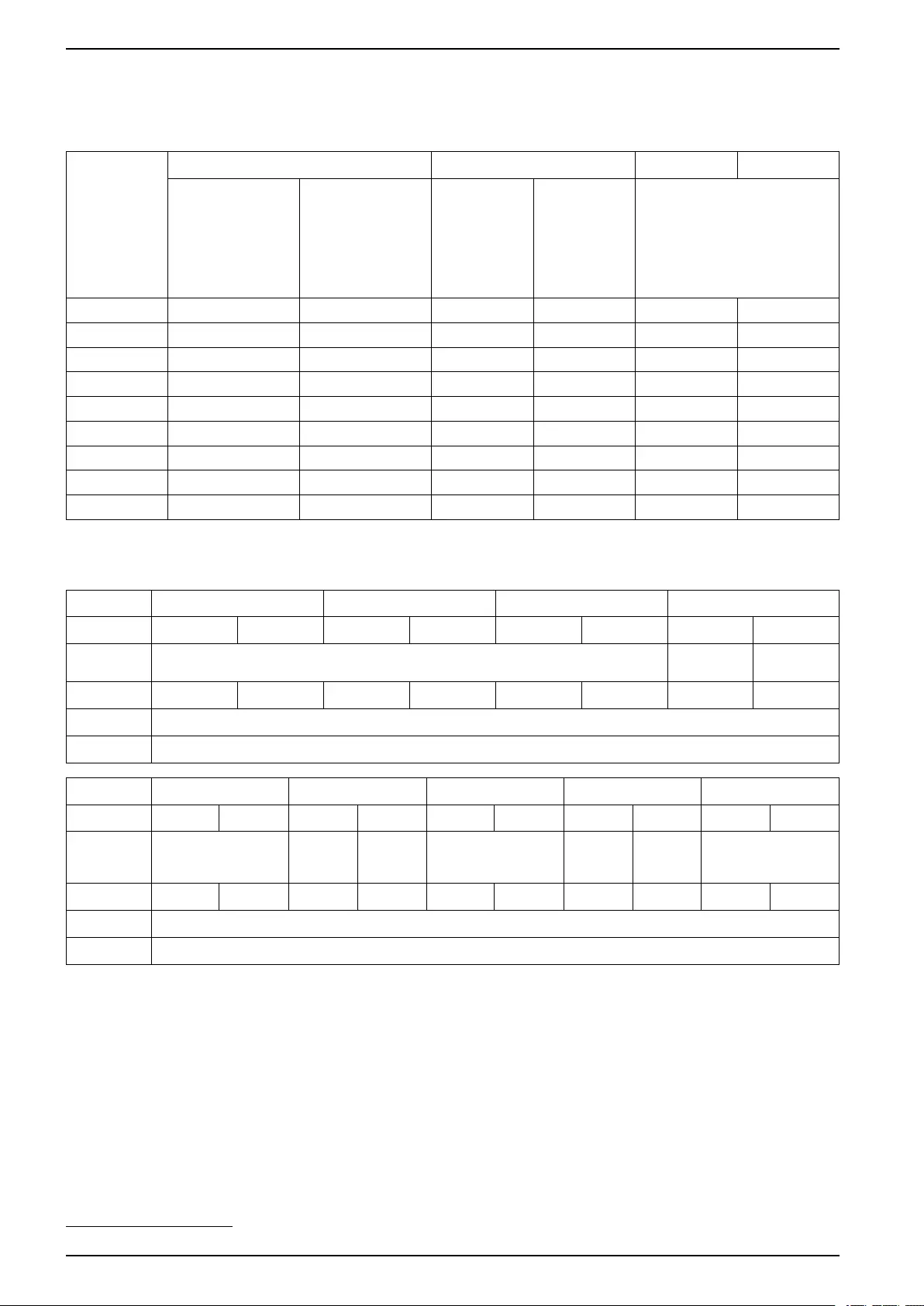
Maintenance Bypass Cabinet Specifications
Specifications for 400 V Systems
Trip Settings for 400/415 V
Rating (kW) Breaker Ir tr at 6 Ir7li (x In)7
Unit input breaker
UIB /
Static switch input
breaker SSIB
Maintenance
bypass breaker
MBB /
Unit output breaker
UOB
Unit input
breaker UIB
Static switch
input breaker
SSIB /
Maintenance
bypass
breaker MBB /
Unit output
breaker UOB
All breakers
20 HJF36150CU31X HJF36150CU31X 50 50 0.5 1.5
30 HJF36150CU31X HJF36150CU31X 60 60 0.5 1.5
40 HJF36150CU31X HJF36150CU31X 80 80 0.5 1.5
50 HJF36150CU31X HJF36150CU31X 100 100 0.5 1.5
60 HJF36150CU31X HJF36150CU31X 125 110 0.5 1.5
80 HJF36150CU31X HJF36150CU31X 150 150 0.5 1.5
100 LJF36400CU31X JJF36250CU31X 200 200 0.5 1.5
120 LJF36400CU31X JJF36250CU31X 225 225 0.5 1.5
150 LJF36400CU31X JJF36250CU31X 300 250 0.5 1.5
Recommended Upstream Protection 400/415 V
Rating 20 kW 30 kW 40 kW 50 kW
Input Bypass Input Bypass Input Bypass Input Bypass
Breaker HJF36100CU31X HJF36150C-
U31X
HJF36100C-
U31X
Ir (A) 50 40 70 60 100 80 125 100
Tr at 6 Ir (A) 0.5
li (x In) (A) 1.5
Rating 60 kW 80 kW 100 kW 120 kW 150 kW
Input Bypass Input Bypass Input Bypass Input Bypass Input Bypass
Breaker HJF36150CU31X JJ-
F36250-
CU31X
HJ-
F36150-
CU31X
JJF36250CU31X LJ-
F36400-
CU31X
JJ-
F36250-
CU31X
LJF36400CU31X
Ir (A) 150 110 200 150 250 200 300 225 350 300
Tr at 6 Ir (A) 0.5
li (x In) (A) 1.5
14 990-5909-001
7. tr and li must be set during installation. The default setting is marked on the breaker.
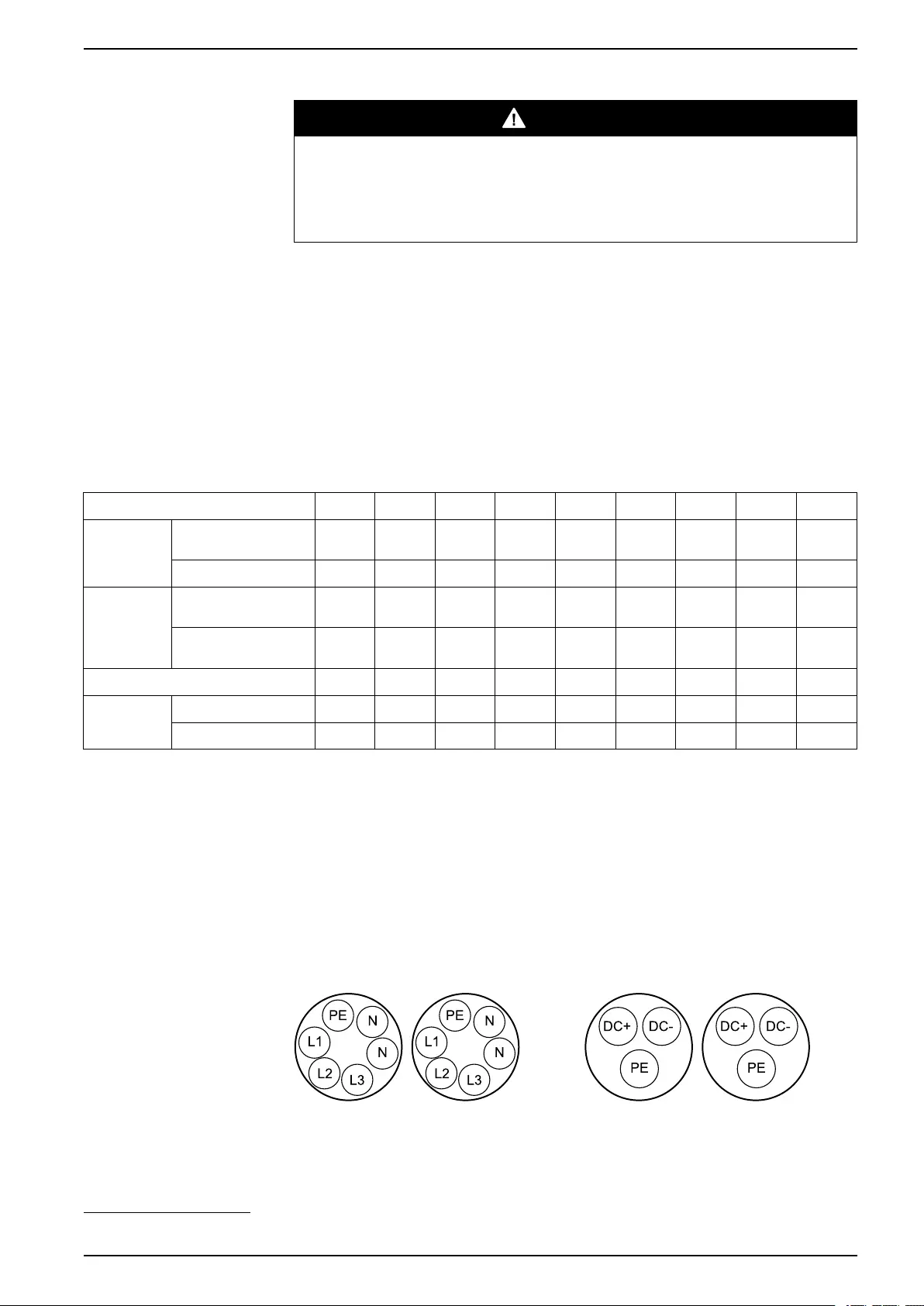
Specifications Maintenance Bypass Cabinet
Recommended Cable Sizes 400/415 V
DANGER
HAZARD OF ELECTRIC SHOCK, EXPLOSION, OR ARC FLASH
All wiring must comply with all applicable national and/or electrical codes. The
maximum allowable cable size is 4/0 AWG.
Failure to follow these instructions will result in death or serious injury.
NOTE: Overcurrent protection is to be provided by others.
Cable sizes in this manual are based on Table 310.15 (B)(16) of the National
Electrical Code (NEC) with the following assertions:
• 90 °C (194 °F) conductors (75 °C (167 °F) termination)
• An ambient temperature of 30 °C (86 °F)
• Use of copper conductors
If the ambient temperature is greater than 30 °C (86 °F), larger conductors are to
be selected in accordance with the correction factors of the NEC.
Equipment grounding conductors (PE in this manual) are sized in accordance with
NEC Article 250.122 and Table 250.122.
Copper 20 kW 30 kW 40 kW 50 kW 60 kW 80 kW 100 kW 120 kW 150 kW
Input Input phases (AWG/
kcmil)
8 4 3 2 1/0 2 x 1/0 2 x 1/0 2 x 1/0 2 x 2/0
Input PE (AWG/kcmil) 10 8 8 6 6 6 2 x 4 2 x 4 2 x 3
Bypass/
output
Bypass/output phases
(AWG/kcmil)
8 6 4 3 2 1/0 2 x 1/0 2 x 1/0 2 x 1/0
Bypass PE/output PE
(AWG/kcmil)
10 10 8 8 6 6 2 x 6 2 x 4 2 x 4
Neutral (AWG/kcmil)86 3 1 2/0 2 x 1/0 2 x 1/0 2 x 2/0 4 x 1/0 4 x 1/0
DC DC +/- (AWG/kcmil) 4 2 1/0 1/0 2/0 4/0 2 x 1/0 2 x 3/0 2 x 4/0
DC PE (AWG/kcmil) 8 6 6 6 6 4 4 3 2 x 2
NOTE: The DC cable sizes given here are recommendations — Always follow
the specific instructions in the battery solution documentation for DC +/- and
DC PE cable sizes.
NOTE: For 100 and 120 kW , use two separate conduits for each of the input,
bypass, and output cable sets. Organize cables as illustrated in each conduit to
avoid eddy currents (heating).
NOTE: For 150 kW, use two separate conduits for each of the input, bypass,
output, and DC cable sets. Organize cables as illustrated in each conduit to
avoid eddy currents (heating).
Cable Organization in Separate Conduits for Input/Bypass/Output and DC
990-5909-001 15
8. Neutral conductor is sized to handle 1.73 times phase current in case of high harmonic content from non-linear loads. If non or less
harmonic currents are expected, neutral conductor can be sized as phase conductor.

Maintenance Bypass Cabinet Specifications
Recommended Bolt and Lug Sizes
NOTICE
RISK OF EQUIPMENT DAMAGE
Use only UL approved compression cable lugs.
Failure to follow these instructions can result in equipment damage.
Copper — One Hole Cable Lugs
Cable size Bolt size Cable lug type Crimping tool Die
10 AWG M8 x 35 mm LCA10-56-L NA NA
8 AWG M8 x 35 mm LCA8-56-L CT-720 CD-720-1 Red P21
6 AWG M8 x 35 mm LCA6-56-L CT-720 CD-720-1 Blue P24
4 AWG M8 x 35 mm LCA4-56-L CT-720 CD-720-1 Gray P29
3 AWG M8 x 35 mm LCA4-56-L CT-720 CD-720-1 Gray P29
2 AWG M8 x 35 mm LCA2-56-Q CT-720 CD-720-1 Brown P33
1 AWG M8 x 35 mm LCA1-56-E CT-720 CD-720-2 Green P37
1/0 AWG M8 x 35 mm LCA1/0-56-X CT-720 CD-720-2 Pink P42
2/0 AWG M8 x 35 mm LCA2/0-56-X CT-720 CD-720-2 Black P45
3/0 AWG M8 x 35 mm LCA3/0-56-X CT-720 CD-720-2 Orange P50
4/0 AWG M8 x 35 mm LCA4/0-56-X CT-720 CD-720-3 Purple P54
Copper — Two Hole Cable Lugs
Cable size Bolt size Cable lug type Crimping tool Die
6 AWG M10 x 35 mm LCC6-12-L CT-930 CD-920-6 Blue P24
4 AWG M10 x 35 mm
LCC4-12-L CT-930 CD-920-4 Gray P29
3 AWG M10 x 35 mm
2 AWG M10 x 35 mm LCC2-12-Q CT-930 CD-920-2 Brown P33
1 AWG M10 x 35 mm LCC1-12-E CT-930 CD-920-1 Green P37
1/0 AWG M10 x 35 mm LCC1/0-12-X CT-930 CD-920-1/0 Pink P42
2/0 AWG M10 x 35 mm LCC2/0-12-X CT-930 CD-920-2/0 Black P45
3/0 AWG M10 x 35 mm LCC3/0-12-X CT-930 CD-920-3/0 Orange P50
4/0 AWG M10 x 35 mm LCC4/0-12-X CT-930 CD-920-4/0 Purple P54
Torque Specifications
Bolt size Torque
M4 1.7 Nm (1.25 lb-ft)
M6 5 Nm (3.69 lb-ft)
M8 17.5 Nm (12.91 lb-ft)
M10 30 Nm (22 lb-ft)
16 990-5909-001
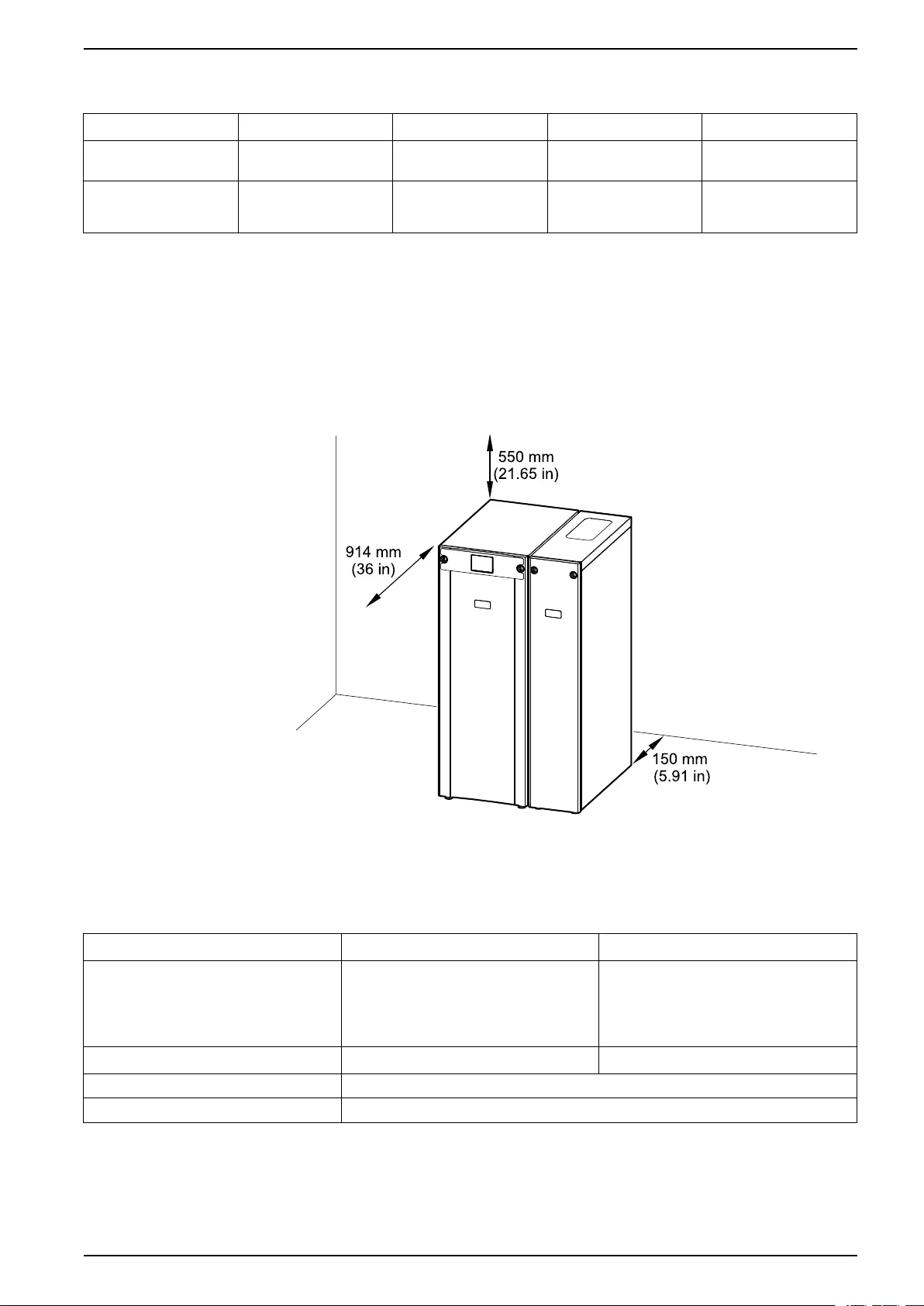
Specifications Maintenance Bypass Cabinet
Maintenance Bypass Cabinet Weights and Dimensions
Weight kg (lbs) Height mm (in) Width mm (in) Depth mm (in)
10–80 kW maintenance
bypass cabinet
110 (242.5) 1485 (58.47) 318 (12.52) 850 (33.46)
100–150 kW
maintenance bypass
cabinet
120 (264.6) 1485 (58.47) 318 (12.52) 850 (33.46)
Clearance
NOTE: Clearance dimensions are published for airflow and service access
only. Consult with the local safety codes and standards for additional
requirements in your local area.
Front View of the UPS and the Maintenance Bypass Cabinet
Environment
Operating Storage
Temperature 0 °C to 40 °C (32 °F to 104 °F ) -25 °C to 55 °C (-13 °F to 131 °F)
Relative humidity 0 – 95% non-condensing 0 – 95% non-condensing
Protection class IP20
Color RAL 9003 white
990-5909-001 17
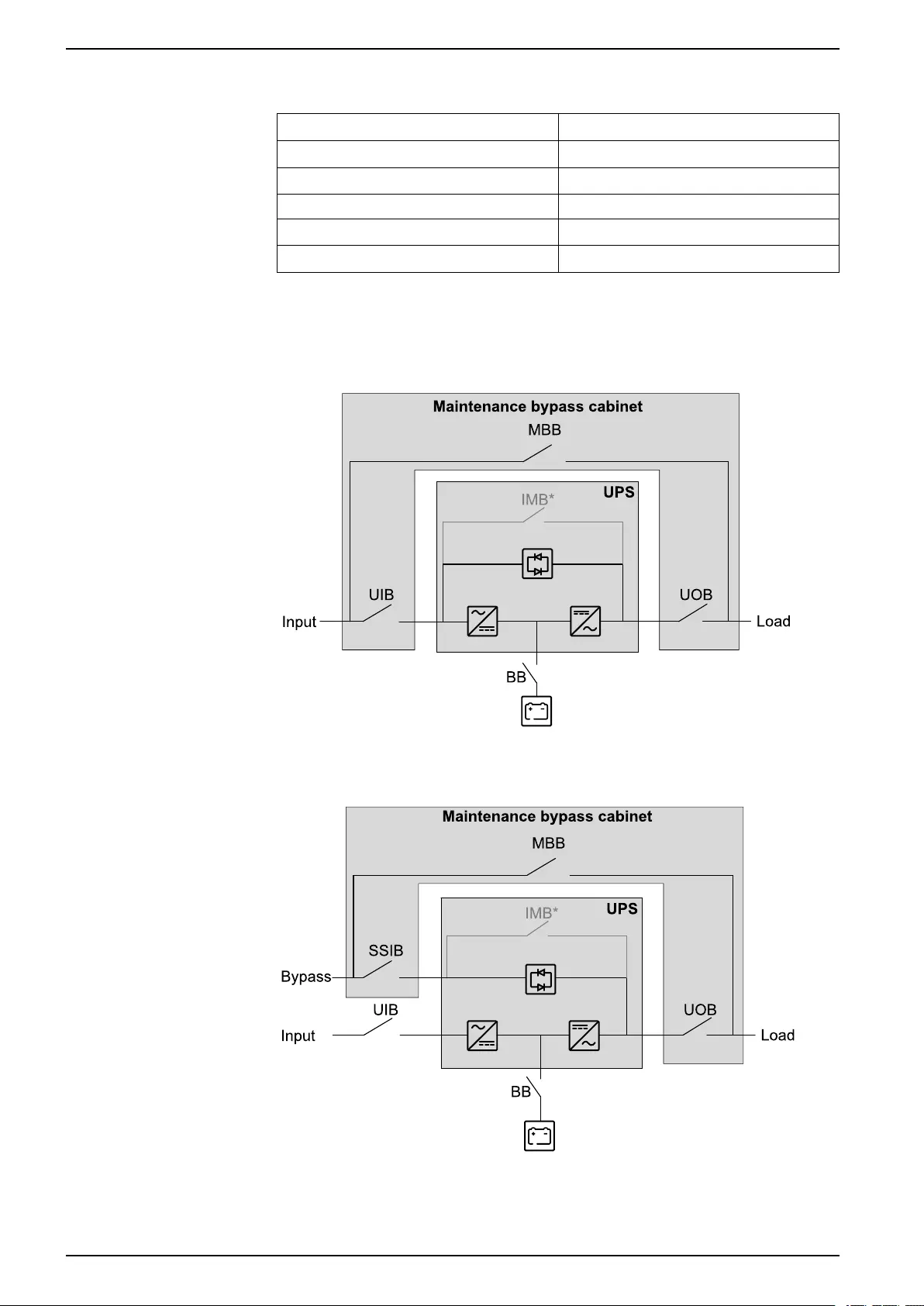
Maintenance Bypass Cabinet Specifications
System Overview
UIB Unit input breaker
SSIB Static switch input breaker
MBB Maintenance bypass breaker
IMB Internal maintenance breaker
UOB Unit output breaker
BB Battery breaker
NOTE: The internal maintenance breaker IMB* in the UPS cannot be used with
a maintenance bypass cabinet and must be padlocked in the open position.
Single Mains UPS System
Dual Mains UPS System
18 990-5909-001
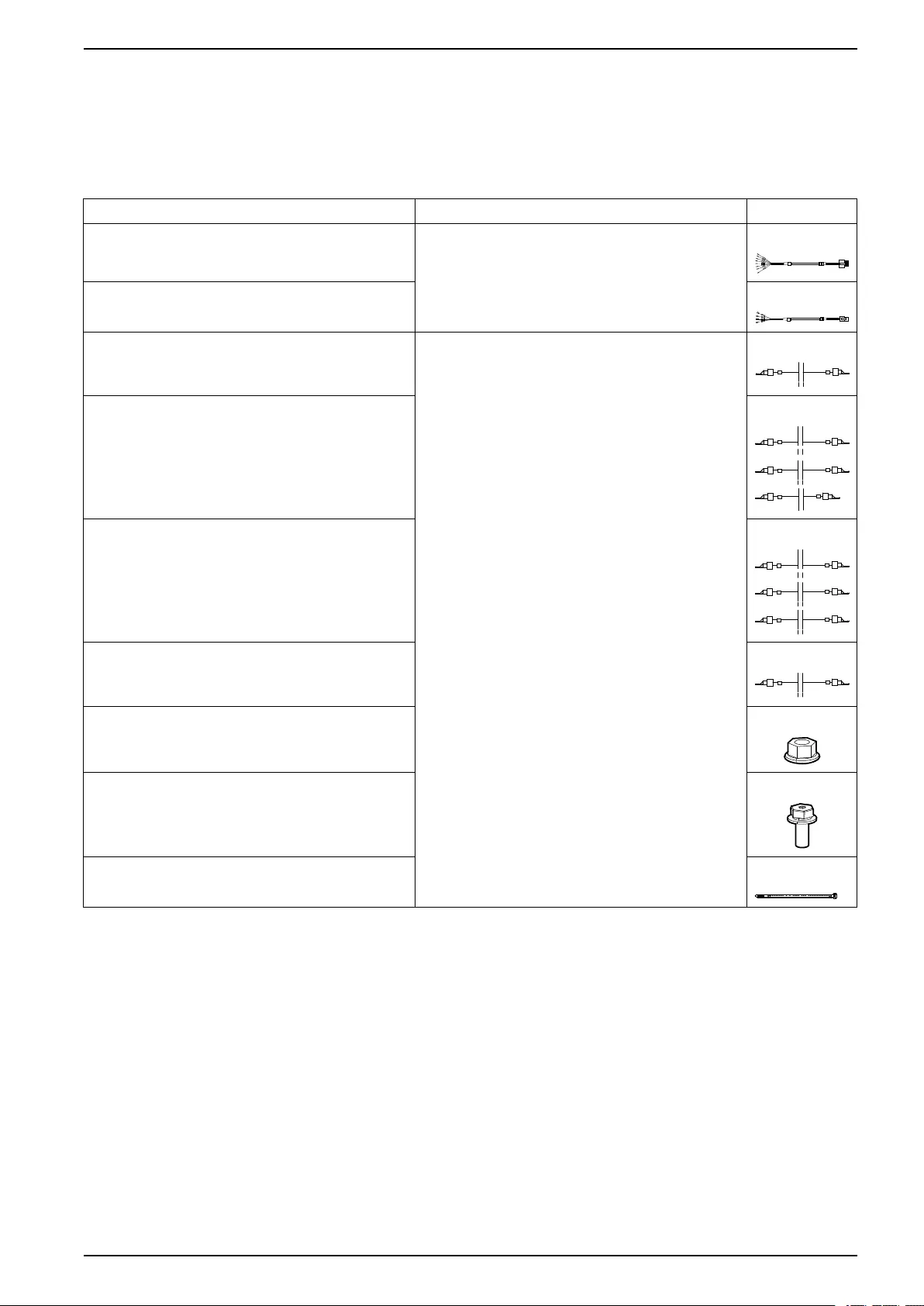
Overview of Installation Kits Maintenance Bypass Cabinet
Overview of Installation Kits
Installation Kit 0M-100265 for 10–80 kW Maintenance Bypass
Cabinet
Part Used in Number of units
0W49284 signal cable Connect the Signal Cables, page 46. 1
0W49283 signal cable 1
0W99053 UPS PE cable Connect the Power Cables in a 10–80 kW Top Cable
Entry System, page 32 or Connect the Power Cables in a
Bottom Cable Entry System, page 38.
1
0W99055 UPS output cables 1
0W99056 UPS input/UPS bypass cables 1
0W99054 UPS neutral cable 1
M8 nut with washer 10
M8 x 25 mm bolt with washer 10
Cable ties 10
990-5909-001 19
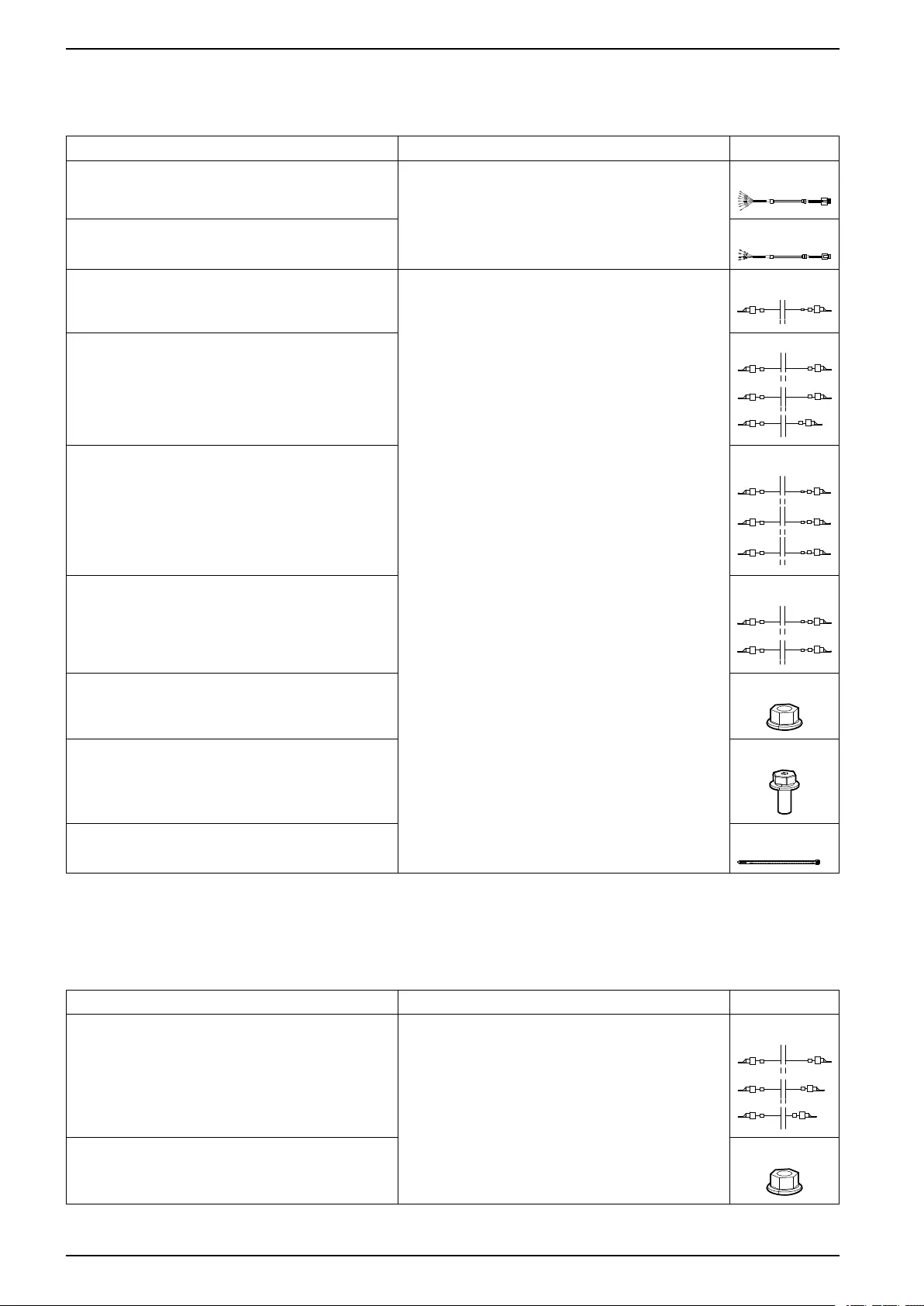
Maintenance Bypass Cabinet Overview of Installation Kits
Installation Kit 0M-100264 for 100–150 kW Maintenance Bypass
Cabinet
Part Used in Number of units
0W49284 signal cable Connect the Signal Cables, page 46. 1
0W49283 signal cable 1
0W99057 UPS PE cable Connect the Power Cables in a 100–150 kW Top Cable
Entry System, page 34, or Connect the Power Cables in a
Bottom Cable Entry System, page 38.
1
0W12375 UPS output cables
0W99058 UPS input/UPS bypass cables 1
0W99052 UPS neutral cable 1
M8 nut with washer 11
M8 x 25 mm bolt with washer 11
Cable ties 10
Installation Kit 0M-100247 for 100–150 kW Maintenance Bypass
Cabinet
Part Used in Number of units
0W49195 UPS input cables (for dual mains) Connect the Power Cables in a 100–150 kW Top Cable
Entry System, page 34.
1
M8 nut with washer 6
20 990-5909-001
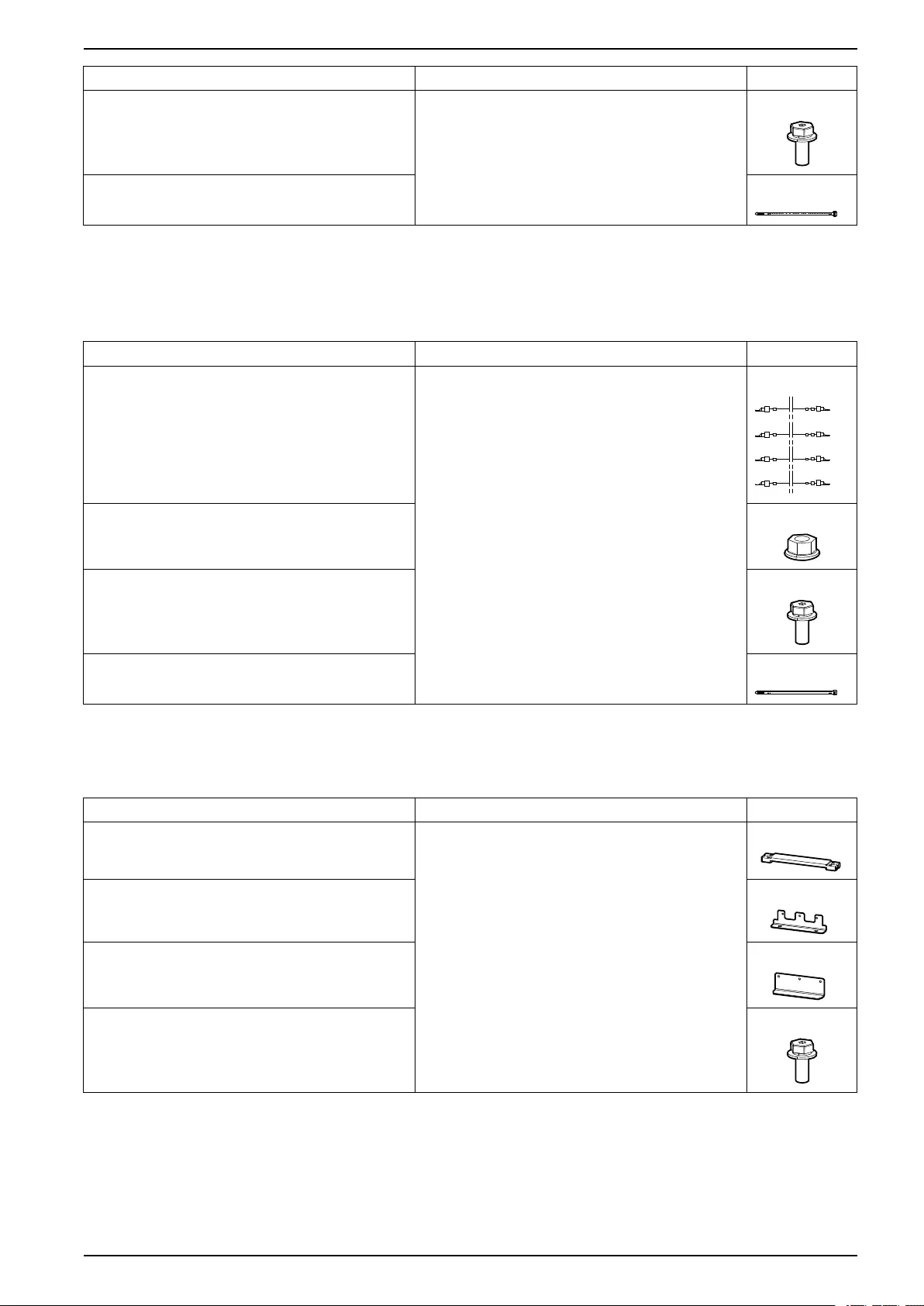
Overview of Installation Kits Maintenance Bypass Cabinet
Part Used in Number of units
M8 x 25 mm bolt with washer 6
Cable ties 10
Installation Kit 0M-100250 for 100–150 kW Maintenance Bypass
Cabinet
Part Used in Number of units
0W49194 UPS DC-cables Connect the Power Cables in a 100–150 kW Top Cable
Entry System, page 34
1
M8 nut with washer 6
M8 x 25 mm bolt with washer 6
Cabel ties 10
Optional Seismic Kit GVSOPT003
Part Used in Number of units
Rear anchor Install the Seismic Anchoring (Option), page 30 and Final
Installation, page 50.
1
Front anchoring bracket 1
Rear anchoring bracket 1
M8 x 20 mm bolt 6
990-5909-001 21
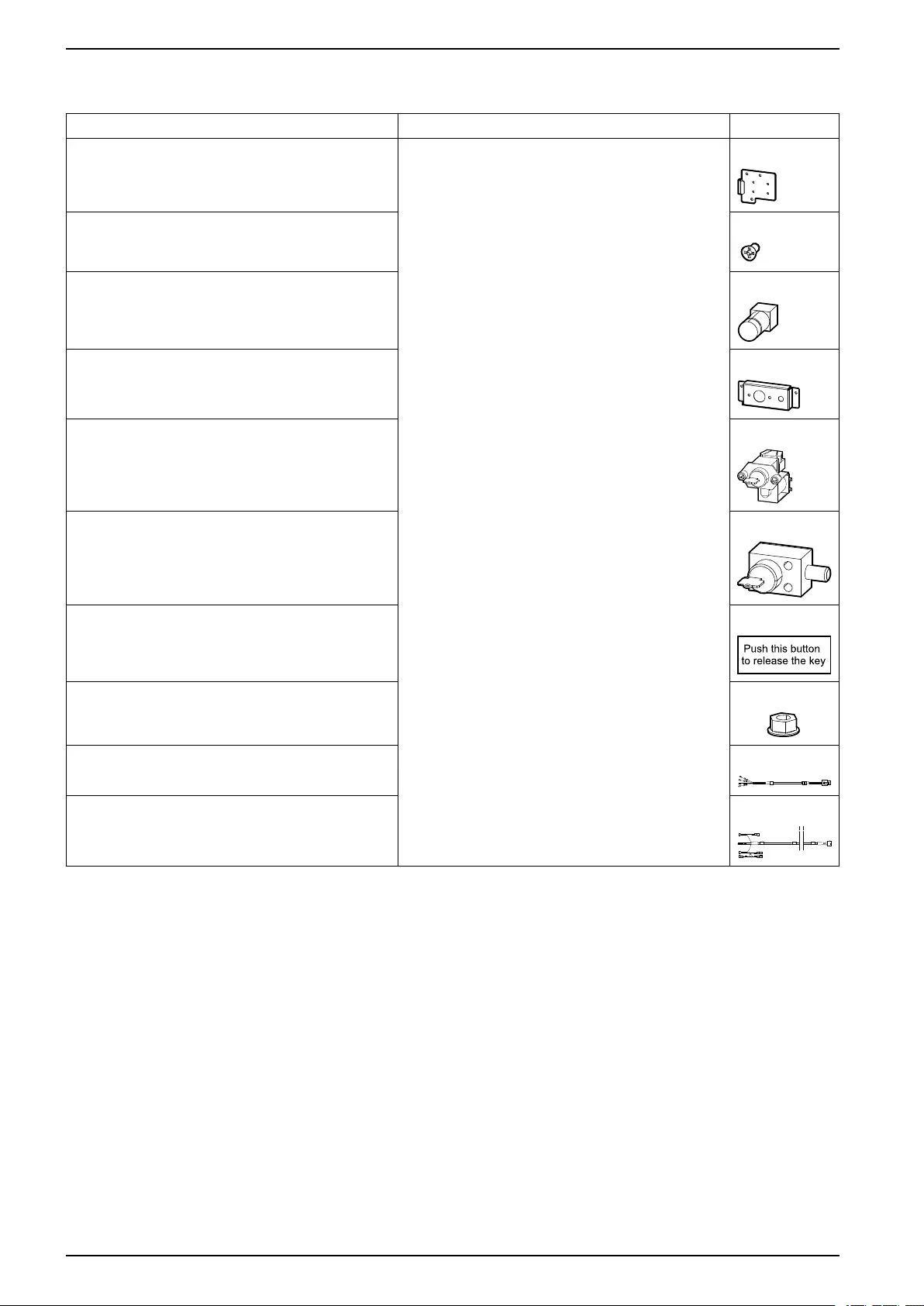
Maintenance Bypass Cabinet Overview of Installation Kits
Optional Kirk Key Kit GVSOPT004
Part Used in Number of units
Support plate The optional kirk key kit will be installed by the Schneider
Electric representative during start-up of your system.
2
Flathead screw 8
Push-button 1
Top support plate 1
Electromechanical key interlock (SKRU) 1
Mechanical key interlock 2
Label 1
M6 nut with washer 2
0W12675 signal cable 1
0W49239 signal cable 1
22 990-5909-001
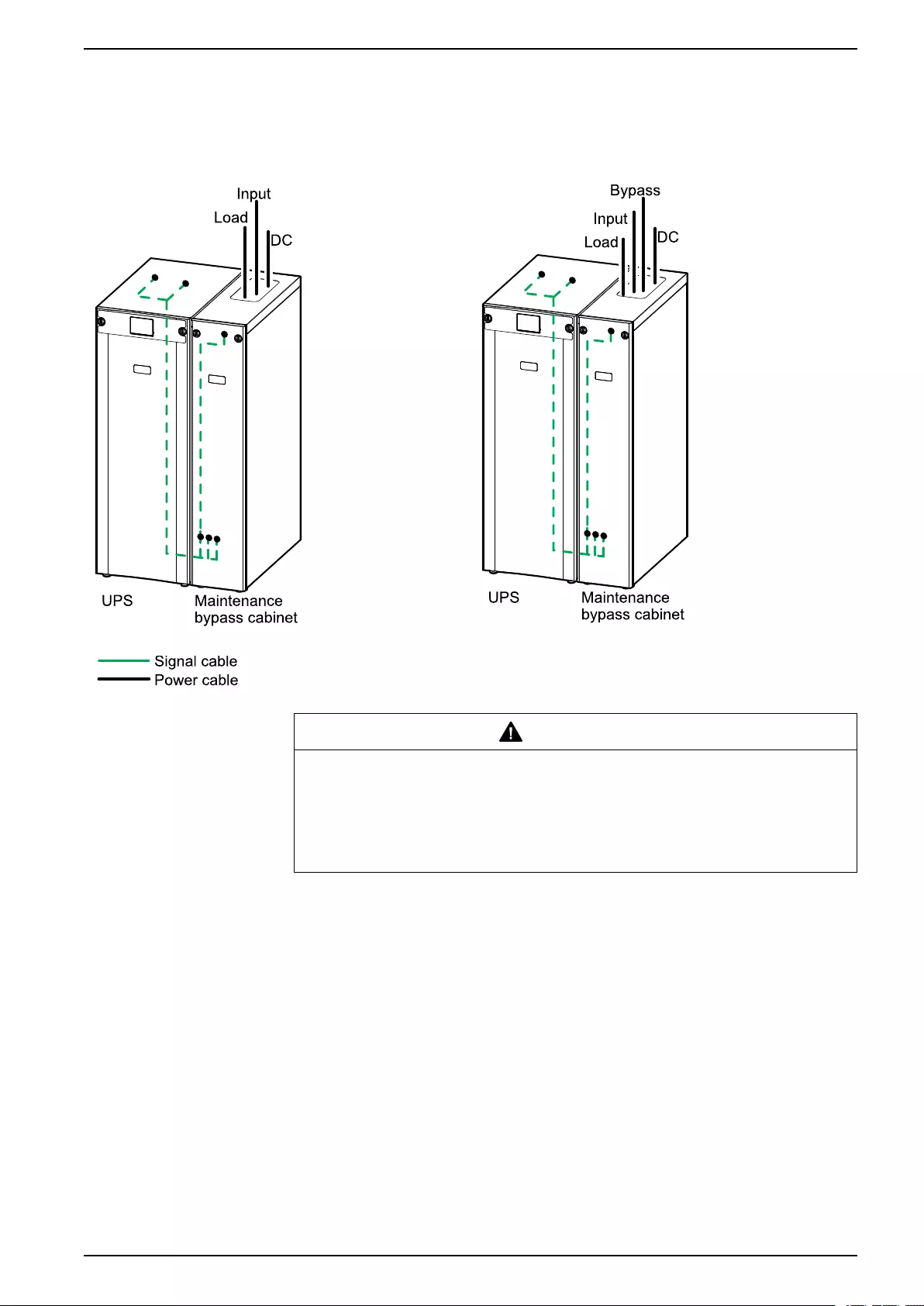
Installation Procedure for Top Cable Entry Maintenance Bypass Cabinet
Installation Procedure for Top Cable Entry
Single Mains Dual Mains
CAUTION
TIP HAZARD
Do not remove the transportation brackets from the maintenance bypass cabinet
until it is time to anchor it to the floor or interconnect it with the UPS.
Failure to follow these instructions can result in injury or equipment
damage.
1. Prepare the Maintenance Bypass Cabinet and the UPS for Cables, page 25.
2. Install the Seismic Anchoring (Option), page 30.
3. Perform one of the following:
–Connect the Power Cables in a 10–80 kW Top Cable Entry System, page
32, or
–Connect the Power Cables in a 100–150 kW Top Cable Entry System,
page 34.
4. Connect the Internal Power Cables, page 39.
5. Interconnect the UPS and the Maintenance Bypass Cabinet, page 42.
6. Connect the Signal Cables, page 46.
7. Final Installation, page 50.
8. Connect all power cables in the UPS – follow the UPS installation manual.
990-5909-001 23
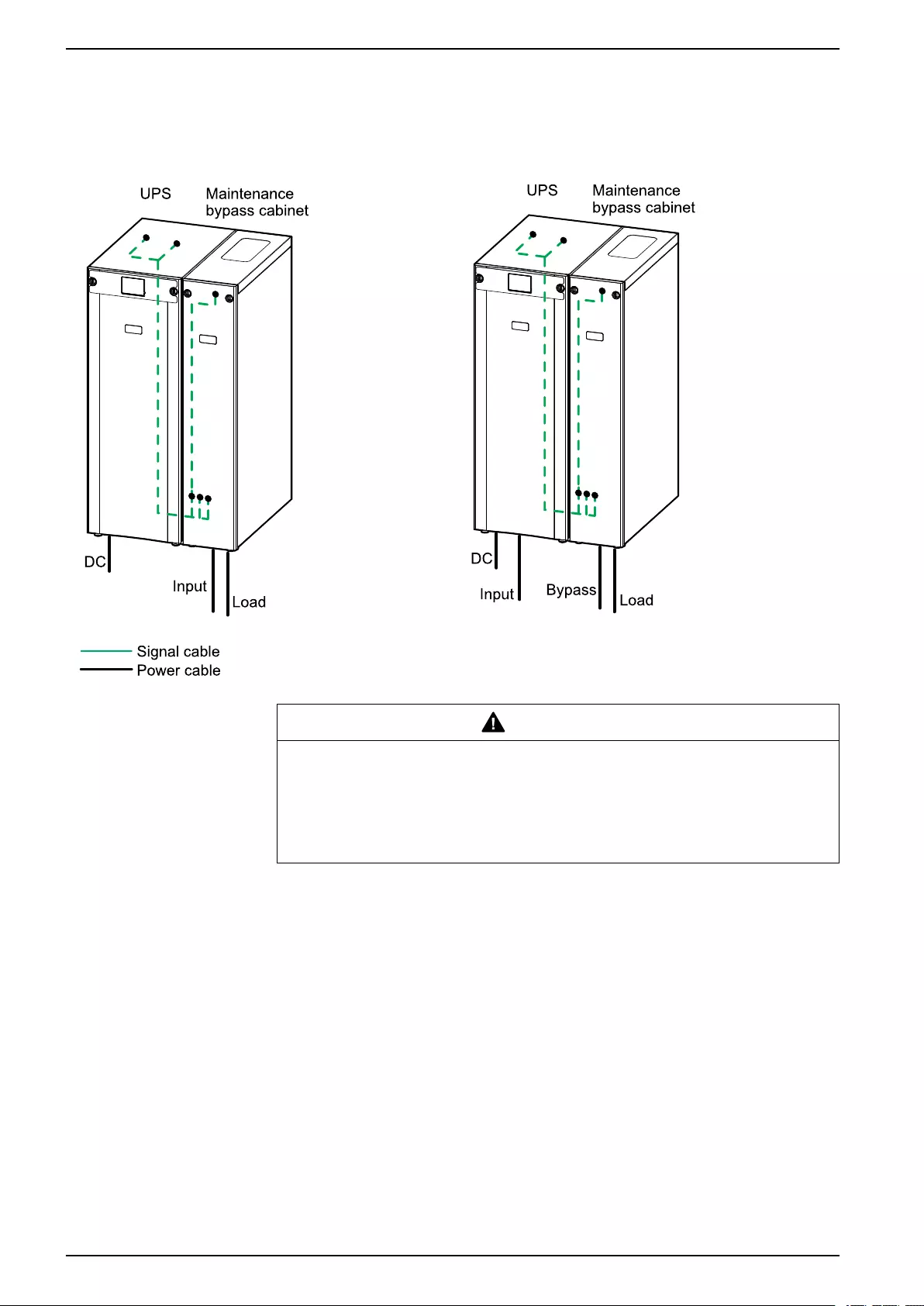
Maintenance Bypass Cabinet Installation Procedure for Bottom Cable Entry
Installation Procedure for Bottom Cable Entry
Single Mains Dual Mains
CAUTION
TIP HAZARD
Do not remove the transportation brackets from the maintenance bypass cabinet
until it is time to anchor it to the floor or interconnect it with the UPS.
Failure to follow these instructions can result in injury or equipment
damage.
1. Prepare the Maintenance Bypass Cabinet and the UPS for Cables, page 25.
2. Install the Seismic Anchoring (Option), page 30.
3. Connect the Power Cables in a Bottom Cable Entry System, page 38.
4. Connect the Internal Power Cables, page 39.
5. Interconnect the UPS and the Maintenance Bypass Cabinet, page 42.
6. Connect the Signal Cables, page 46.
7. Final Installation, page 50.
8. Connect all power cables in the UPS – follow the UPS installation manual.
24 990-5909-001
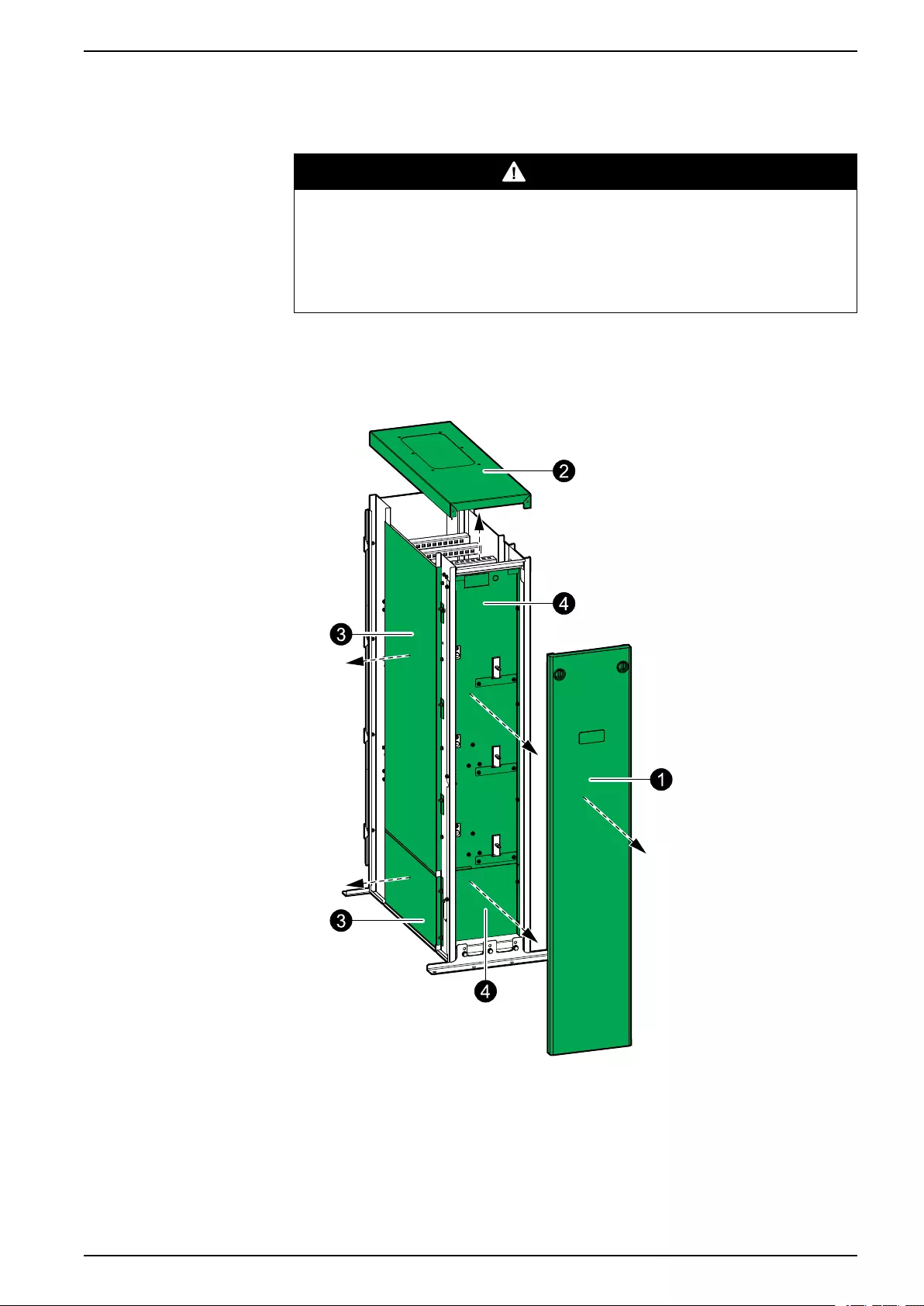
Prepare the Maintenance Bypass Cabinet and the UPS for
Cables Maintenance Bypass Cabinet
Prepare the Maintenance Bypass Cabinet and the
UPS for Cables
DANGER
HAZARD OF ELECTRIC SHOCK, EXPLOSION, OR ARC FLASH
Do not drill or cut holes for power cables or conduits with the gland plate
installed and do not drill or cut holes in close proximity to the maintenance
bypass cabinet.
Failure to follow these instructions will result in death or serious injury.
1. Remove the front panel from the maintenance bypass cabinet.
Front View of the Maintenance Bypass Cabinet
2. Remove the top cover from the maintenance bypass cabinet.
3. Remove the upper and lower left side plate from the maintenance bypass
cabinet. Save the upper left side plate for later.
4. Remove the lower and upper front plate from the maintenance bypass
cabinet.
990-5909-001 25
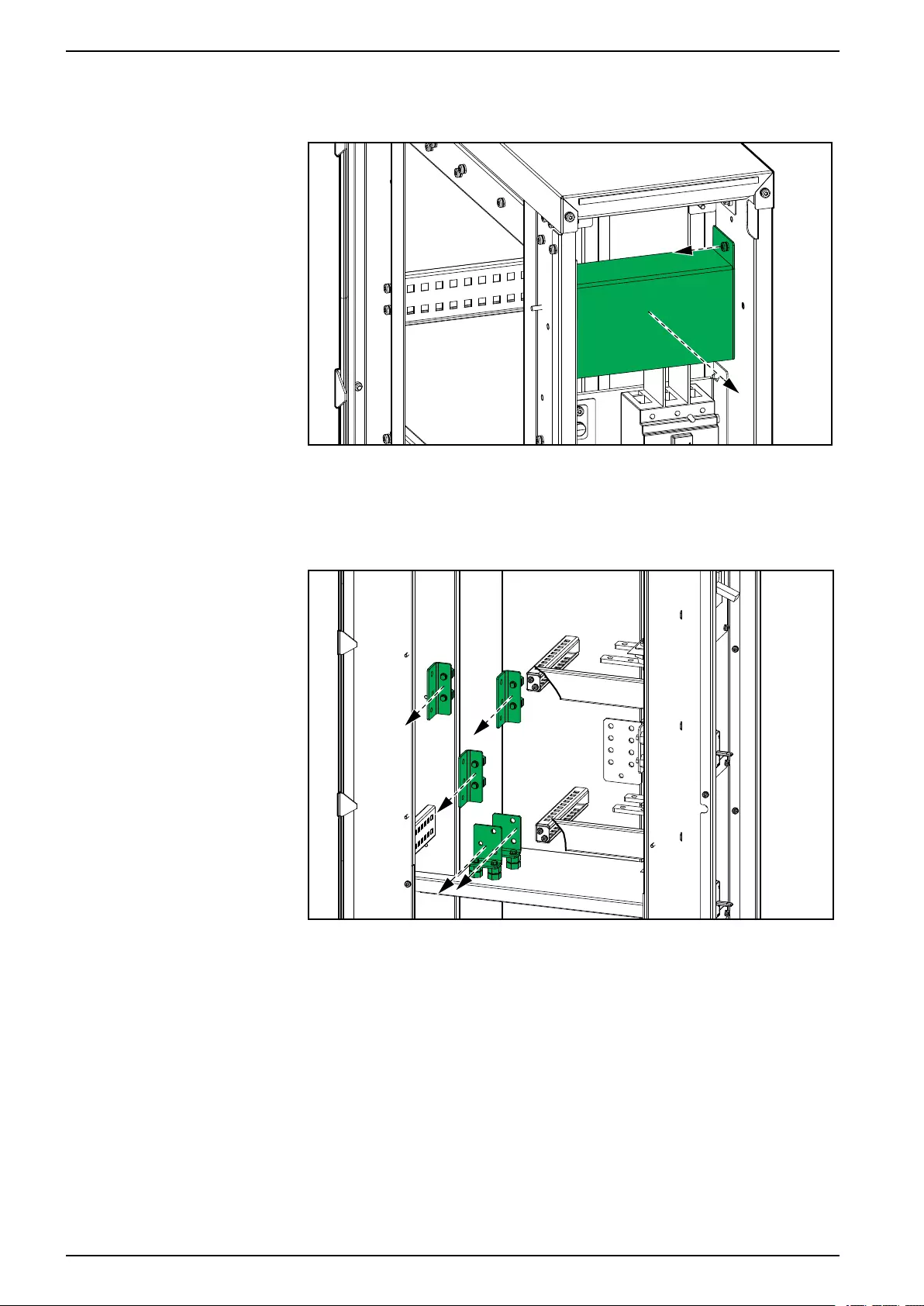
Maintenance Bypass Cabinet
Prepare the Maintenance Bypass Cabinet and the UPS for
Cables
5. Remove the transparent plate above the top breaker.
Front View of the Maintenance Bypass Cabinet
6. Only for bottom cable entry in 100–150 kW maintenance bypass cabinet:
Remove the indicated busbars and insulators in the maintenance bypass
cabinet for more cable routing space.
Left Side View of the 100–150 kW Maintenance Bypass Cabinet
26 990-5909-001
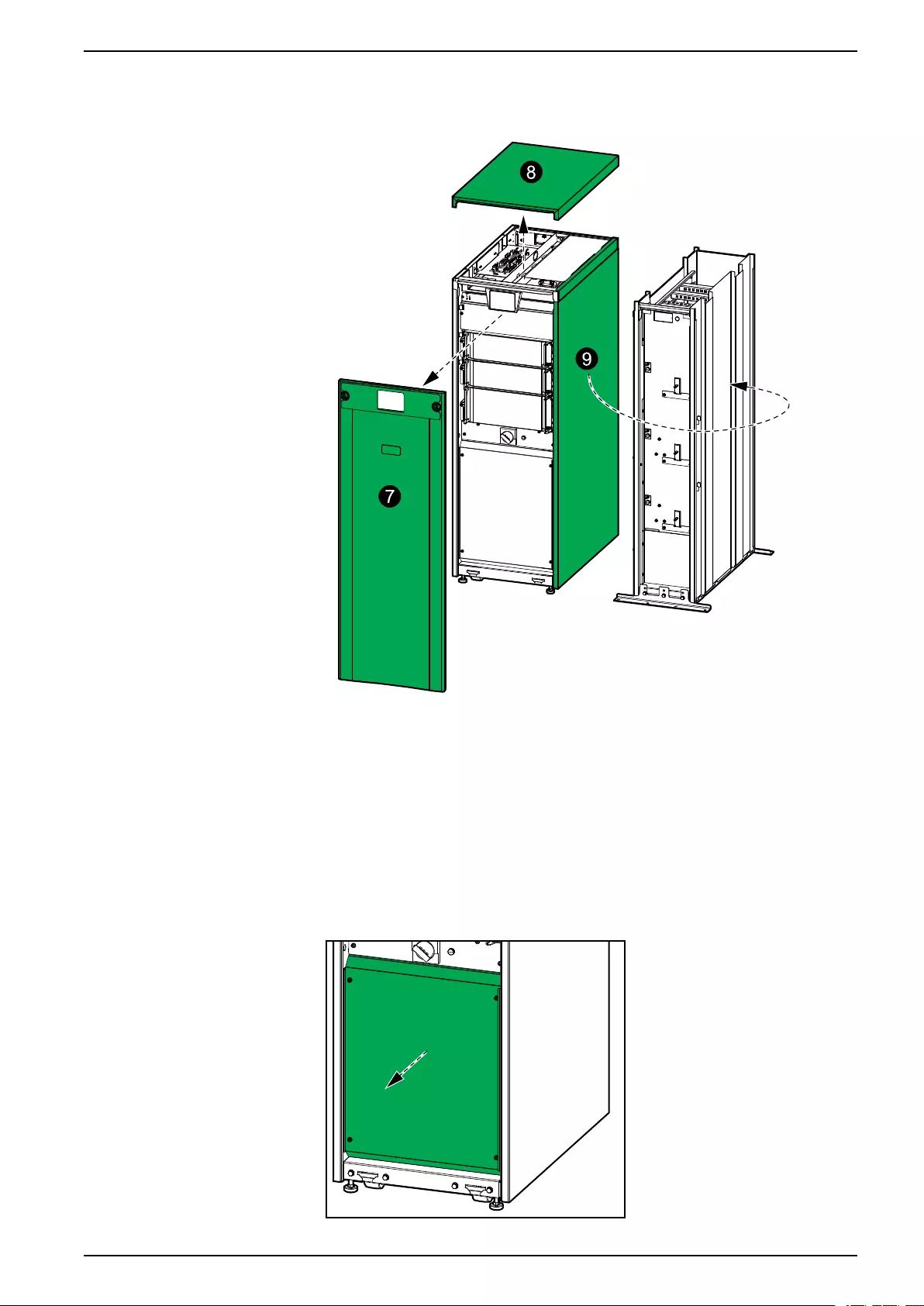
Prepare the Maintenance Bypass Cabinet and the UPS for
Cables Maintenance Bypass Cabinet
7. Remove the front panel from the UPS.
Front View of the UPS and the Maintenance Bypass Cabinet
8. Remove the top cover from the UPS:
a. Remove the screws and tilt the front of the top cover upwards.
b. Slide the top cover towards the rear to remove it. Taps in the rear of the
top cover must disconnect from the slots in the rear of the UPS.
9. Remove the right side panel from the UPS and reinstall the side panel on the
right side of the maintenance bypass cabinet.
10. Remove the front plate from the UPS.
Front View of the UPS
990-5909-001 27
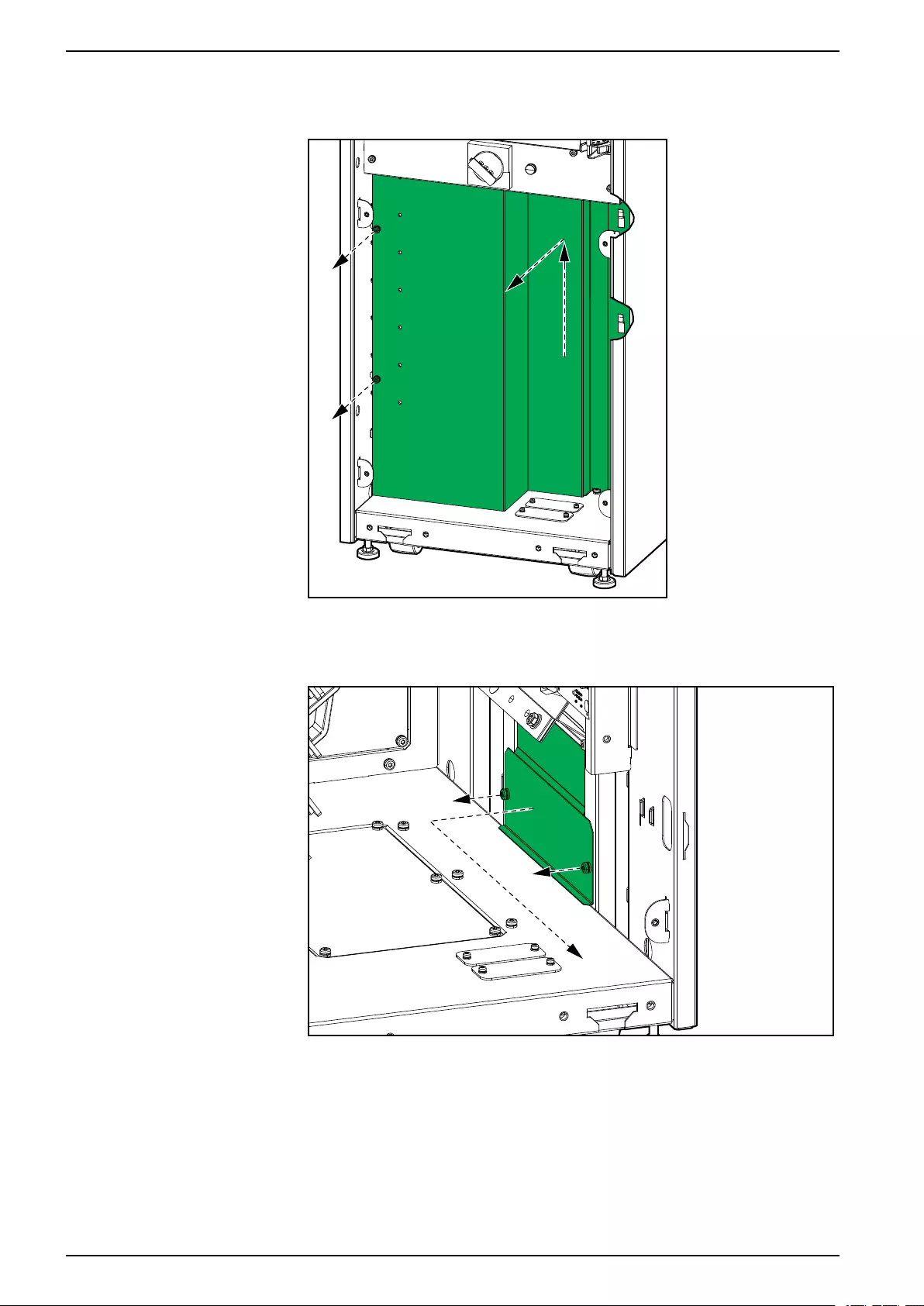
Maintenance Bypass Cabinet
Prepare the Maintenance Bypass Cabinet and the UPS for
Cables
11. Remove the transparent plate from the UPS.
Front View of the UPS
12. Remove the lower right side plate from the UPS.
Front View of the UPS
13. Only for top cable entry system:
a. Remove the gland plate from the top cover of the maintenance bypass
cabinet.
b. Drill or punch holes for power cables or conduits in the gland plate.
Conduits are not provided.
c. Reinstall the gland plate in the top cover of the maintenance bypass
cabinet.
28 990-5909-001

Prepare the Maintenance Bypass Cabinet and the UPS for
Cables Maintenance Bypass Cabinet
14. Only for bottom cable entry system:
a. Remove the gland plate from the bottom of the maintenance bypass
cabinet.
b. Drill or punch holes for power cables or conduits in the gland plate.
Conduits are not provided.
c. Reinstall the gland plate in the bottom of the maintenance bypass cabinet
15. Reinstall the top cover on the maintenance bypass cabinet with four screws.
990-5909-001 29
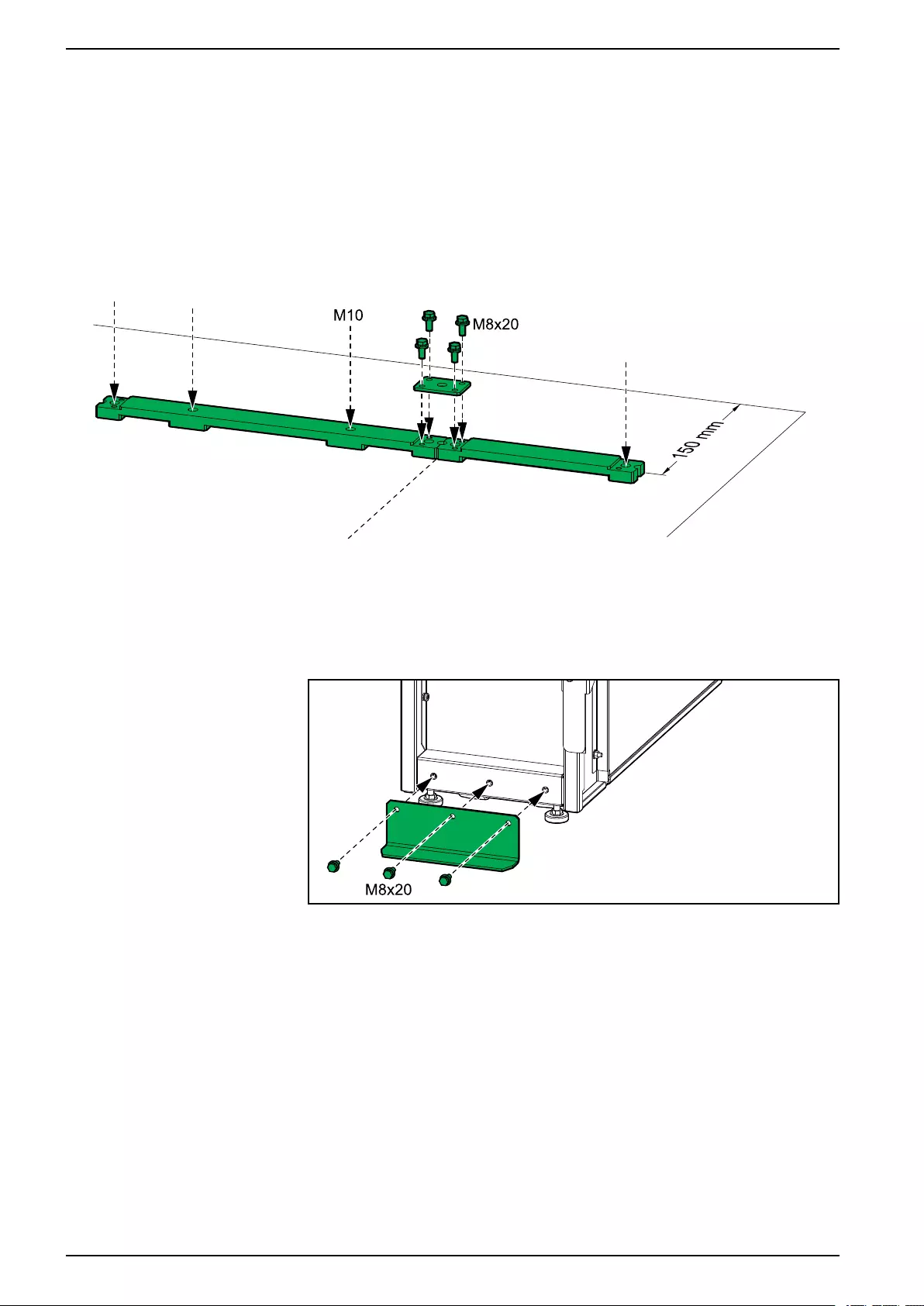
Maintenance Bypass Cabinet Install the Seismic Anchoring (Option)
Install the Seismic Anchoring (Option)
Use the optional installation kits GVSOPT002 (shipped with the UPS) and
GVSOPT003 for this procedure.
1. Interconnect the rear anchors for the UPS (on the left) and the maintenance
bypass cabinet (on the right) with the interconnection plate and four M8 bolts
(provided).
2. Mount the rear anchor assembly to the floor with M10 expansion bolts (not
provided).
3. Remove the transportation brackets from the maintenance bypass cabinet.
4. Install the rear anchoring brackets on the UPS and the maintenance bypass
cabinet with the M8 bolts (provided).
Rear View of the Maintenance Bypass Cabinet
30 990-5909-001

Install the Seismic Anchoring (Option) Maintenance Bypass Cabinet
5. Push the maintenance bypass cabinet into position so the rear anchoring
bracket connects to the rear anchor. The front anchoring bracket is installed in
the final installation steps.
NOTE: Do not push the UPS into position yet.
Rear View of the Maintenance Bypass Cabinet
990-5909-001 31
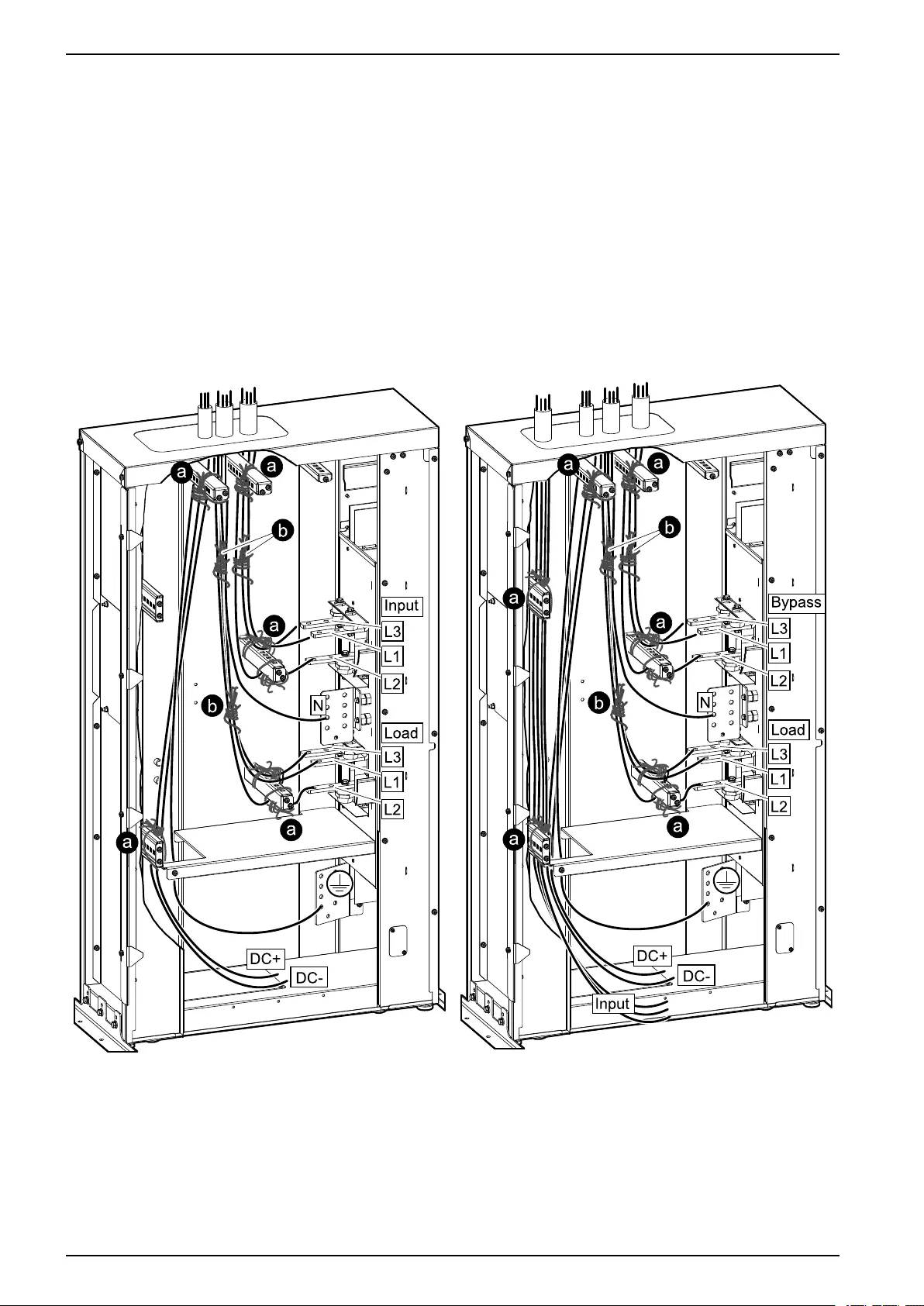
Maintenance Bypass Cabinet
Connect the Power Cables in a 10–80 kW Top Cable Entry
System
Connect the Power Cables in a 10–80 kW Top Cable
Entry System
1. The power cables must be restrained with 3/8 nylon rope:
a. Tie the power cables to the beams with rope as illustrated. Make sure that
the rope holds the cables tightly in place. Note that L2 is routed under the
beam and L1 and L3 is routed over the beam in front of the busbars.
b. Tie the power cables together with rope as illustrated halfway between
the two beams. See Restrain the Cables, page 36 for restrain method.
Left Side View of the Maintenance Bypass Cabinet
– Single Mains
Left Side View of the Maintenance Bypass Cabinet
– Dual Mains
2. Perform one of the following:
–Only for single mains system: Route the input cables and load cables
through the top of the maintenance bypass cabinet and connect to the
input busbars, the load busbars, and the PE-busbar.
–Only for dual mains system: Route the bypass cables and load cables
through the top of the maintenance bypass cabinet and connect to the
bypass busbars, the load busbars, and the PE-busbar.
32 990-5909-001

Connect the Power Cables in a 10–80 kW Top Cable Entry
System Maintenance Bypass Cabinet
3. Only for dual mains system: Route the input cables through the top of the
maintenance bypass cabinet and out through the left side of the maintenance
bypass cabinet.
4. Route the DC-cables through the top of the maintenance bypass cabinet and
out through the left side of the maintenance bypass cabinet.
990-5909-001 33
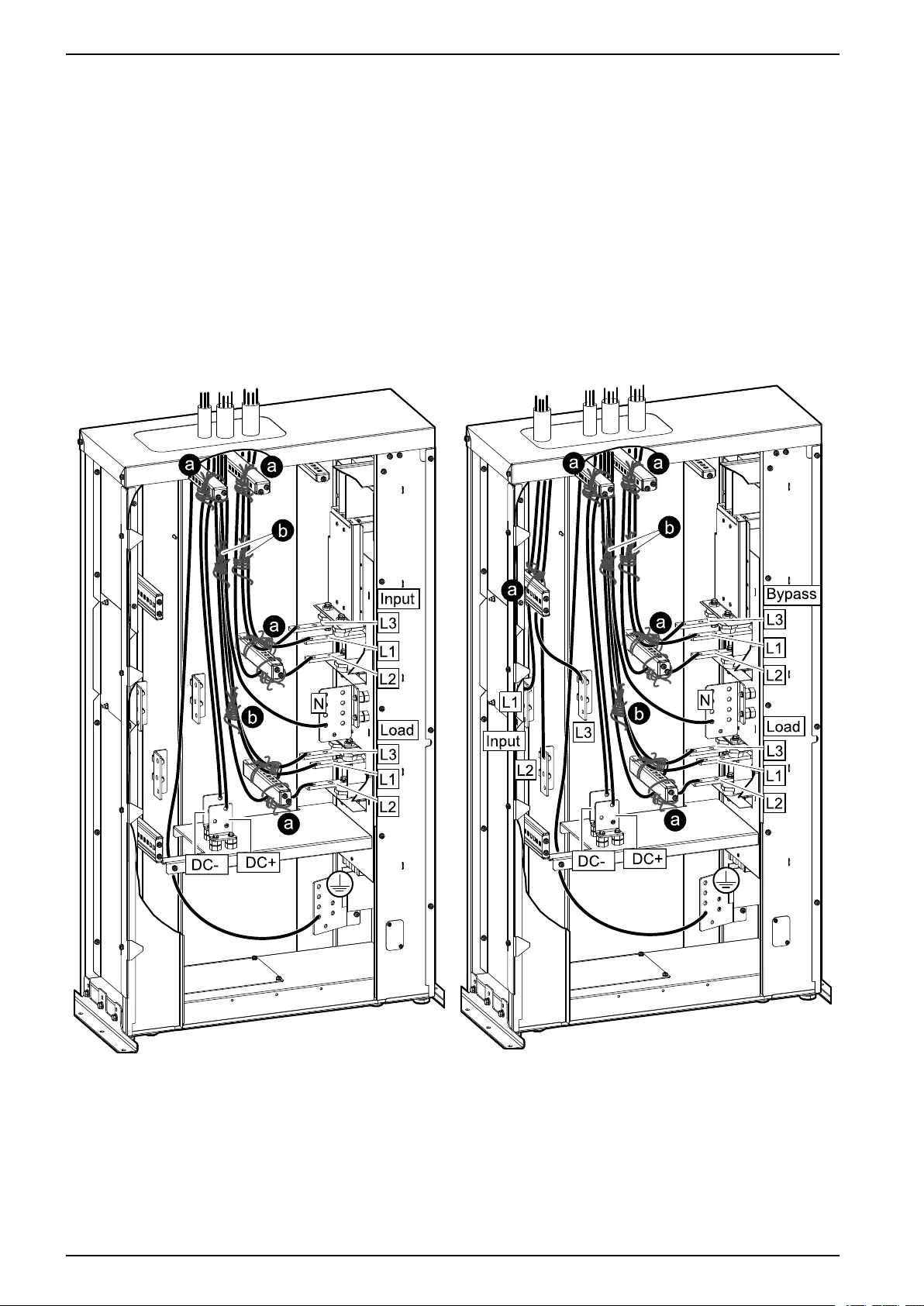
Maintenance Bypass Cabinet
Connect the Power Cables in a 100–150 kW Top Cable Entry
System
Connect the Power Cables in a 100–150 kW Top
Cable Entry System
1. The power cables must be restrained with 3/8 nylon rope:
a. Tie the power cables to the beams with rope as illustrated. Make sure that
the rope holds the cables tightly in place. Note that L2 is routed under the
beam and L1 and L3 is routed over the beam in front of the busbars.
b. Tie the power cables together with rope as illustrated halfway between
the two beams. See Restrain the Cables, page 36 for restrain method.
Left Side View of the Maintenance Bypass Cabinet
– Single Mains
Left Side View of the Maintenance Bypass Cabinet
– Dual Mains
2. Perform one of the following:
–Only for single mains system: Route the input cables and the load
cables through the top of the maintenance bypass cabinet and connect to
the input busbars, the load busbars, and the PE-busbar.
–Only for dual mains system: Route the input cables, the bypass cables
and the load cables through the top of the maintenance bypass cabinet
and connect to the input busbars, the bypass busbars, the load busbars,
and the PE-busbar.
34 990-5909-001
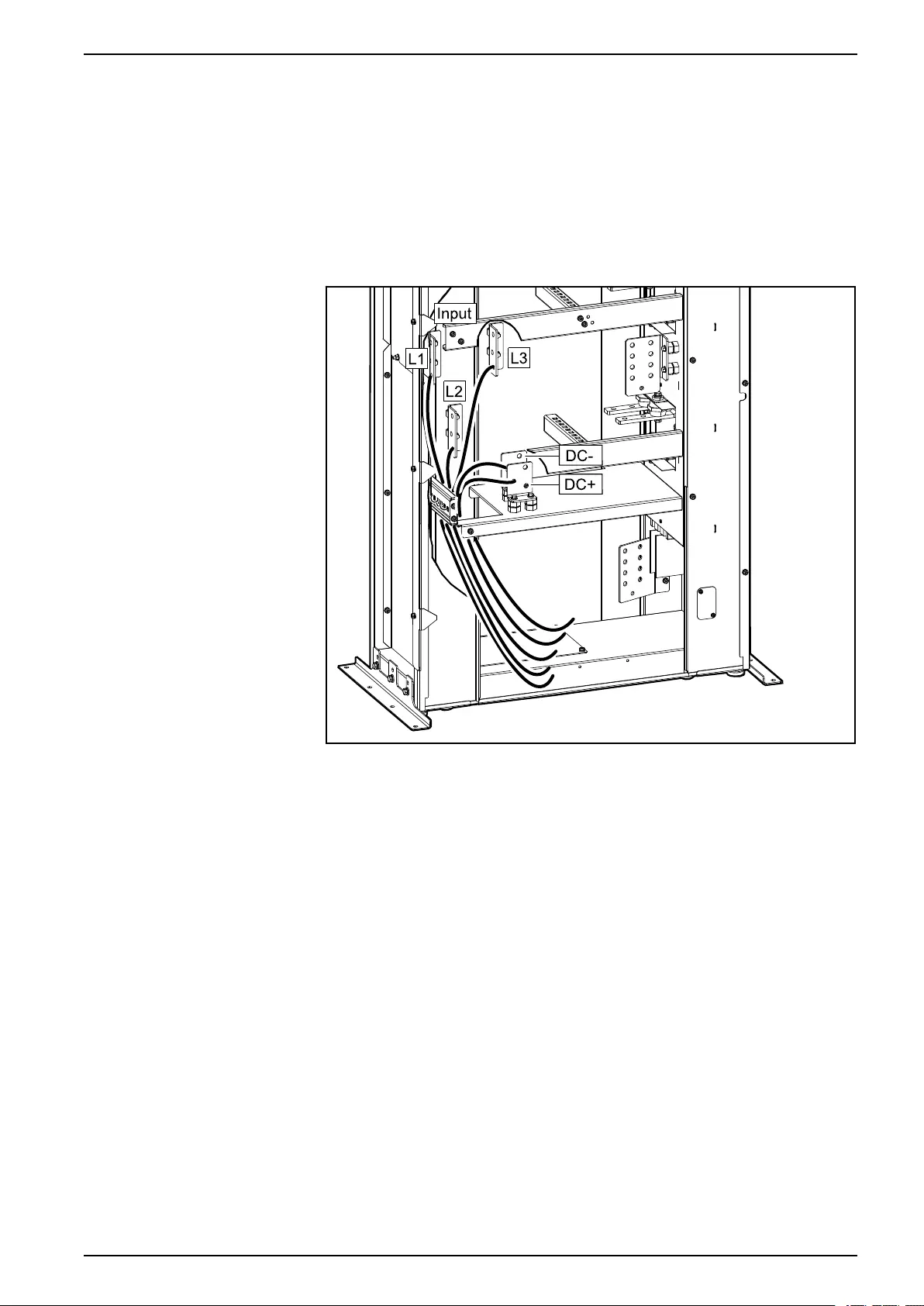
Connect the Power Cables in a 100–150 kW Top Cable Entry
System Maintenance Bypass Cabinet
3. Route the DC-cables through the top of the maintenance bypass cabinet and
connect to the DC-busbars (DC+, DC–) and the PE-busbar.
4. Connect the provided UPS DC-cables to the DC-busbars (DC+, DC-) and
route the cables out through the left side of the maintenance bypass cabinet.
Fasten the cables to the beam with cable ties.
5. Only for dual mains system: Connect the provided UPS input cables to the
input busbars and route the cables out through the left side of the
maintenance bypass cabinet. Fasten the cables to the beam with cable ties.
Left Side View of the Maintenance Bypass Cabinet
990-5909-001 35
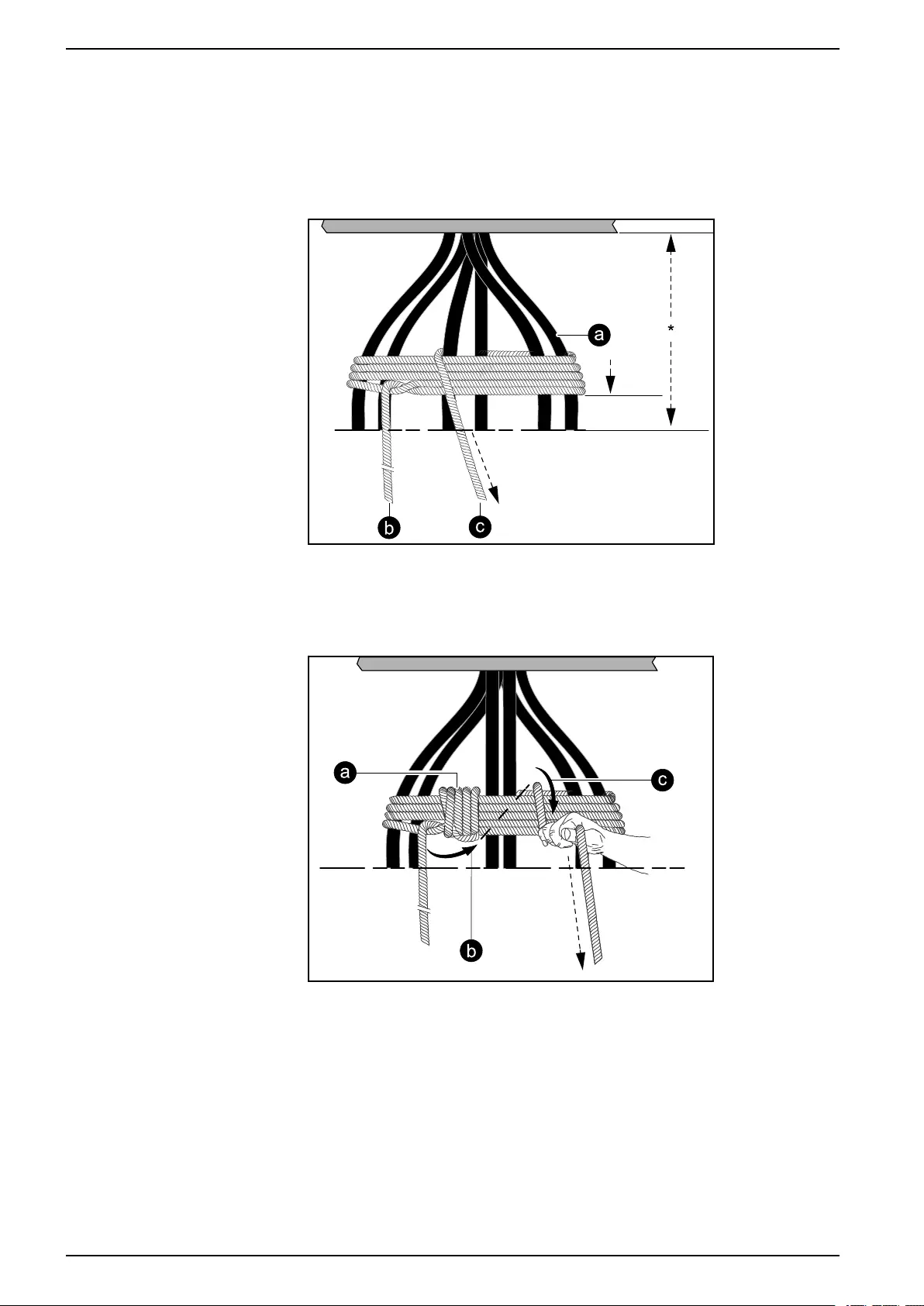
Maintenance Bypass Cabinet Restrain the Cables
Restrain the Cables
Use 3/8 in nylon rope to restrain the cables.
1. Wrap the rope around the cables (a). Wrap the cables four times leaving 1 m
(3 ft) of excess rope at the first end (b). Pull rope (c) taut.
* Unsupported cable length.
2. Wrap rope (a) several times until the space between the first two sets of
cables is completely filled. Weave final rope loop underneath the previous loop
(b). Bring rope (c) through the other open area and pull the rope taut.
36 990-5909-001
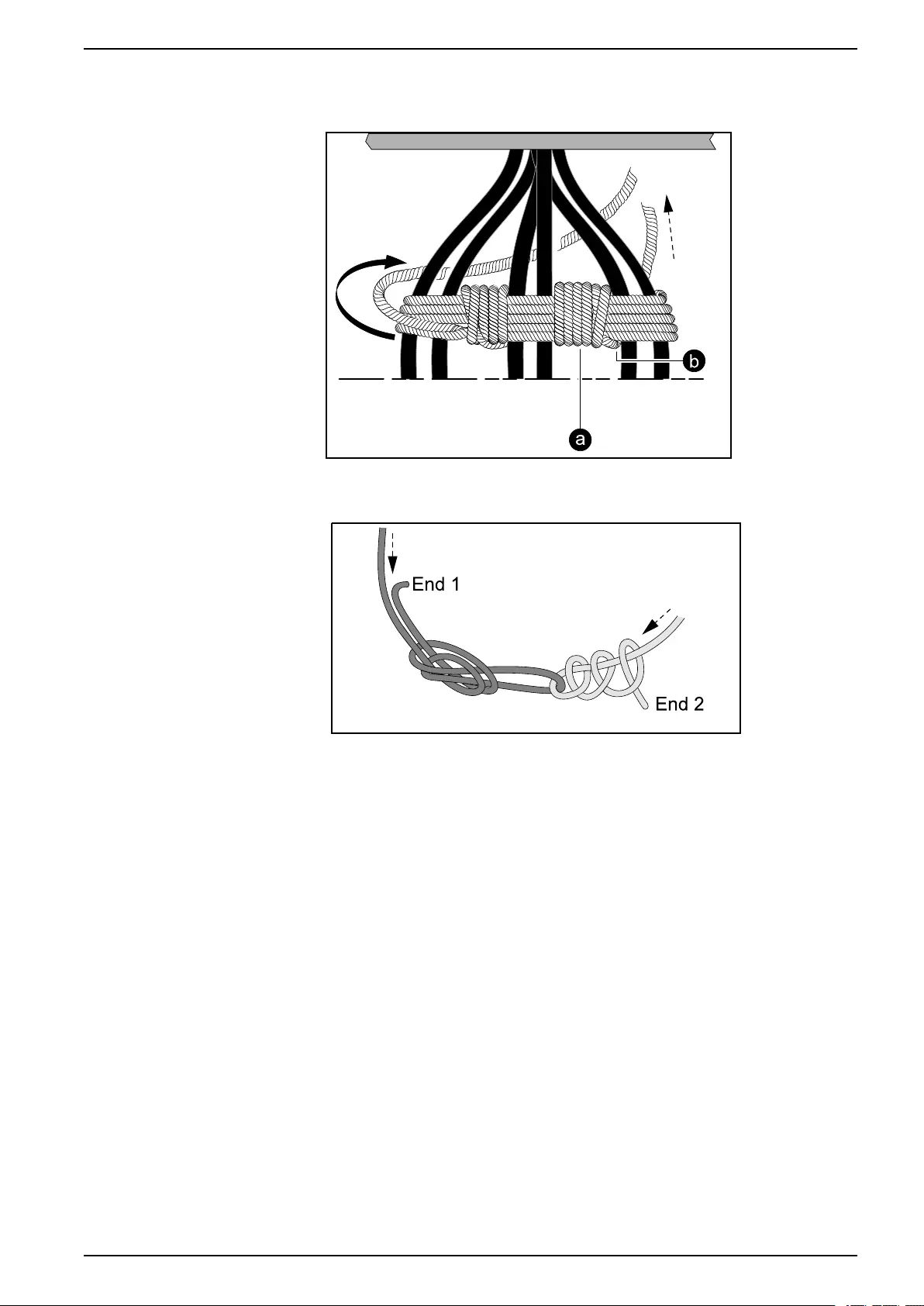
Restrain the Cables Maintenance Bypass Cabinet
3. Wrap rope (a) several times until the space between the second and the third
set of cables is completely filled. Wave the final rope loop (b) underneath the
previous loop as shown. Pull the rope taut.
4. Tie rope End 1 and End 2 together as shown. The rope must be taut. Cut off
excess rope and tape ends to prevent fraying.
5. Repeat the procedure where needed.
990-5909-001 37
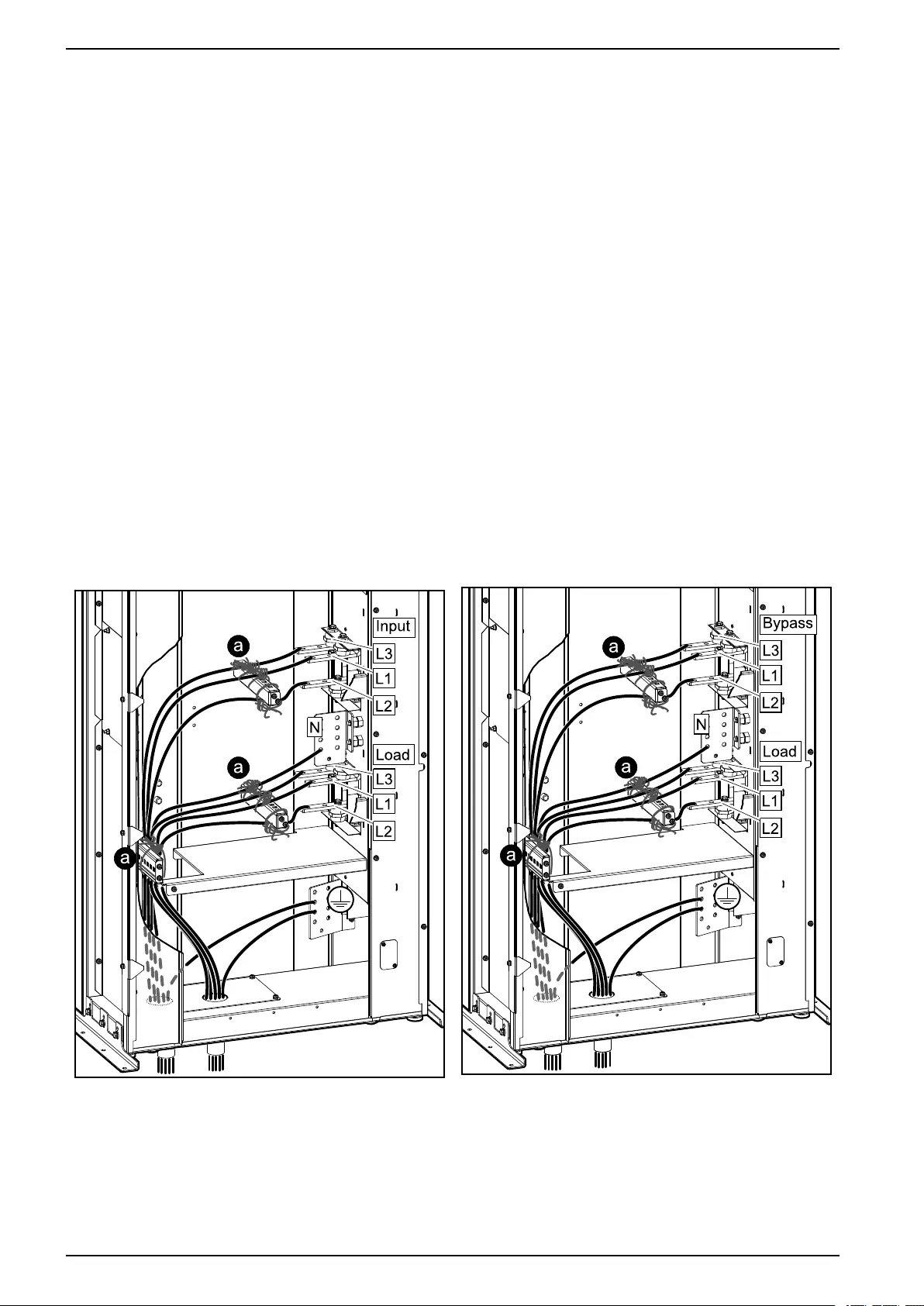
Maintenance Bypass Cabinet Connect the Power Cables in a Bottom Cable Entry System
Connect the Power Cables in a Bottom Cable Entry
System
NOTE: DC-cables are routed through the bottom of the UPS. Follow the UPS
installation manual to install the DC-cables.
NOTE: Input cables in dual mains systems are routed through the bottom of
the UPS. Follow the UPS installation manual to install the input cables.
1. Perform one of the following:
–Only for single mains system: Route the input cables and the load
cables through the bottom of the maintenance bypass cabinet and connect
to the input busbars, the load busbars, and the PE-busbar.
–Only for dual mains system: Route the bypass cables and the load
cables through the bottom of the maintenance bypass cabinet and connect
to the bypass busbars, the load busbars, and the PE-busbar.
2. The power cables must be restrained with 3/8 nylon rope:
a. Tie the power cables to the beams with rope as illustrated. Make sure that
the rope holds the cables tightly in place. Note that L2 is routed under the
beam and L1 and L3 is routed over the beam in front of the busbars.
Left Side View of the Maintenance Bypass Cabinet
– Single Mains
Left Side View of the Maintenance Bypass Cabinet
– Dual Mains
38 990-5909-001
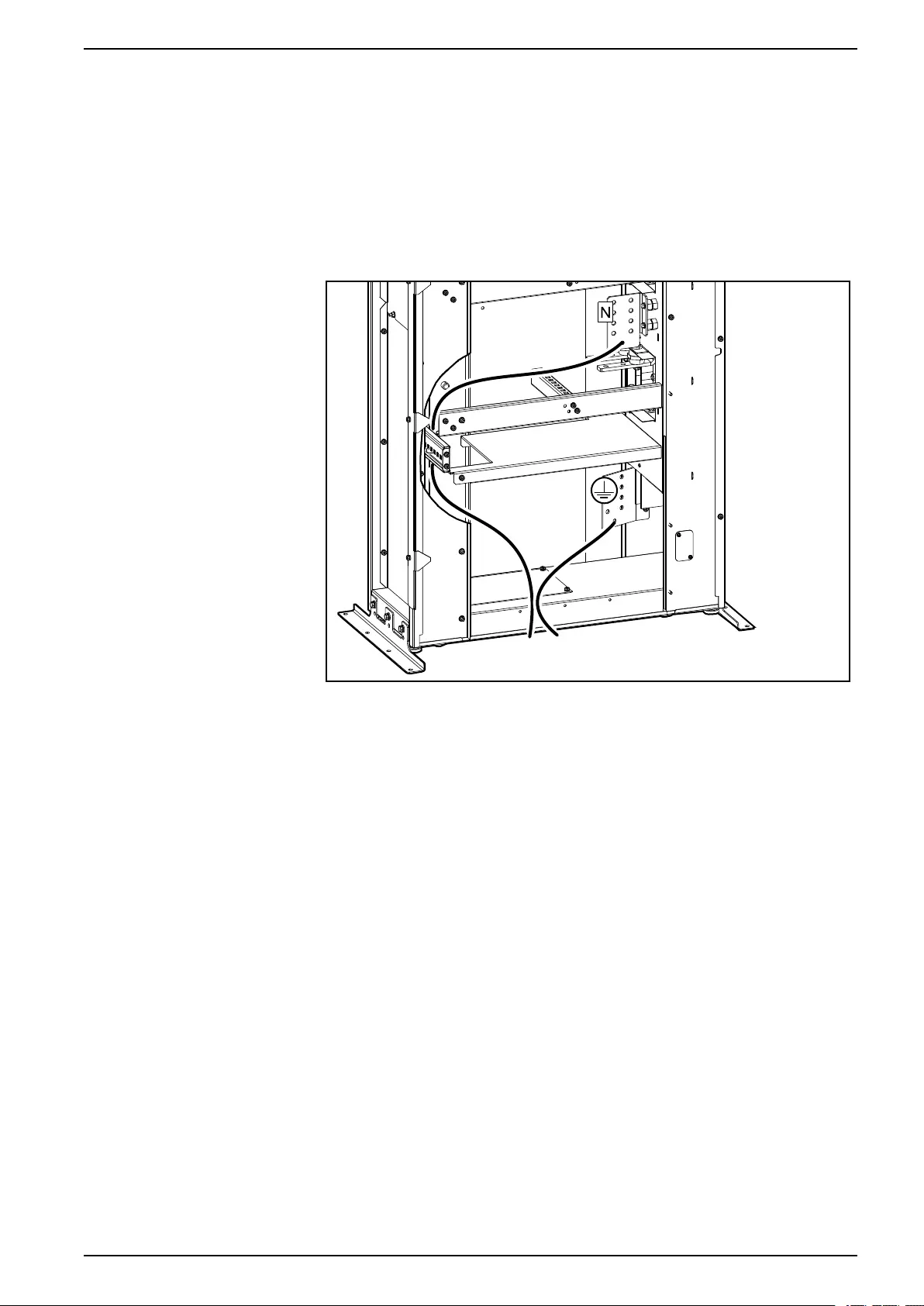
Connect the Internal Power Cables Maintenance Bypass Cabinet
Connect the Internal Power Cables
1. Connect the provided UPS PE cable to the PE busbar and route the cable out
through the left side of the maintenance bypass cabinet.
2. Connect the provided UPS N cable to the N busbar and route the cable out
through the left side of the maintenance bypass cabinet. Fasten the N cable to
the beam with a cable tie.
Left Side View of the Maintenance Bypass Cabinet
990-5909-001 39
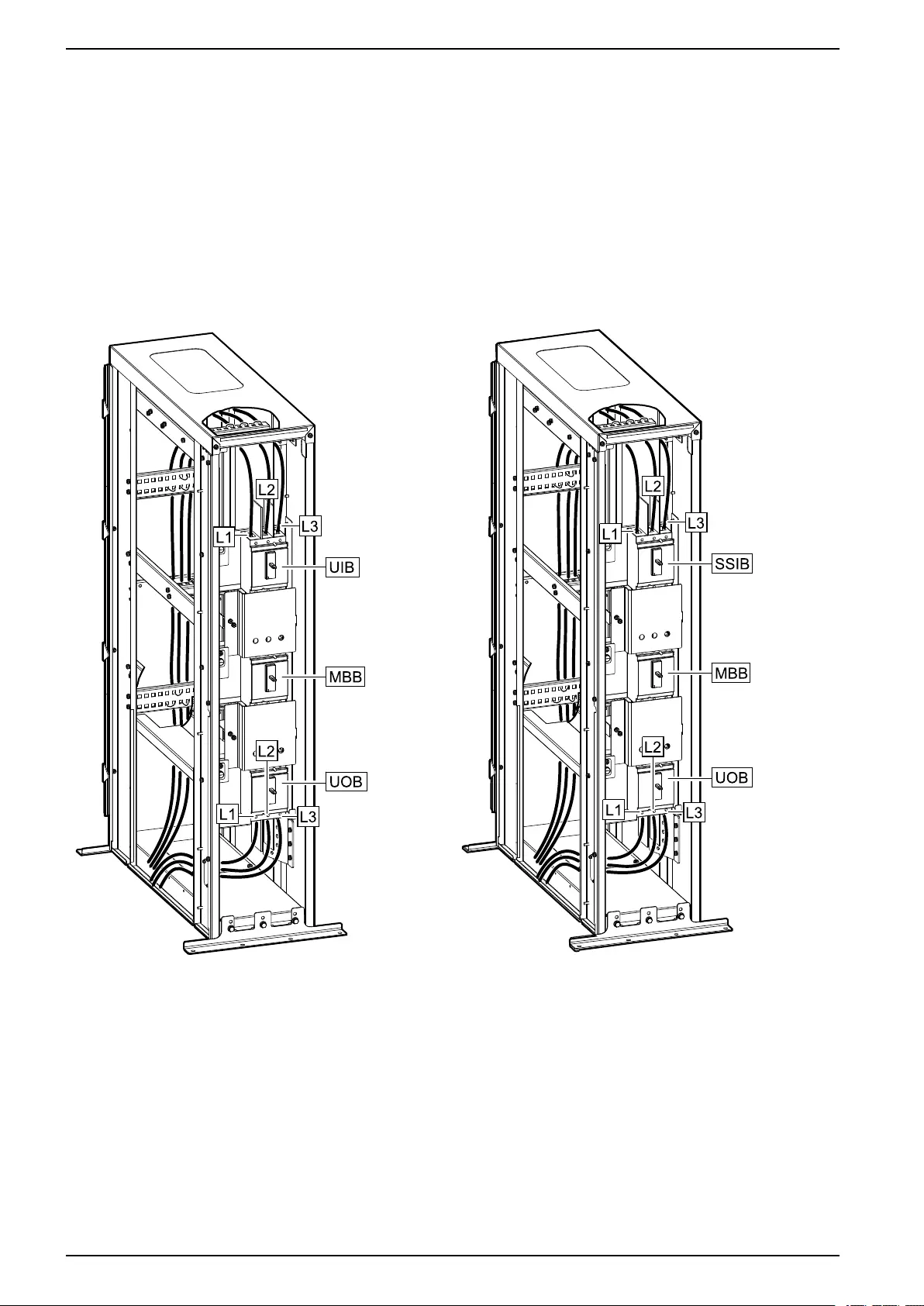
Maintenance Bypass Cabinet Connect the Internal Power Cables
3. Perform one of the following:
–Only for single mains system: Connect the provided UPS input cables to
the unit input breaker UIB (L1, L2, L3) and route the cables out through the
left side of the maintenance bypass cabinet. Fasten the cables to the
beams with cable ties.
–Only for dual mains system: Connect the provided UPS bypass cables to
the static switch input breaker SSIB (L1, L2, L3) and route the cables out
through the left side of the maintenance bypass cabinet. Fasten the cables
to the beams with cable ties.
Front View of the Maintenance Bypass Cabinet –
Single Mains
Front View of the Maintenance Bypass Cabinet –
Dual Mains
4. Connect the provided UPS output cables to the unit output breaker UOB (L1,
L2, L3) and route the cables out through the left side of the maintenance
bypass cabinet.
40 990-5909-001
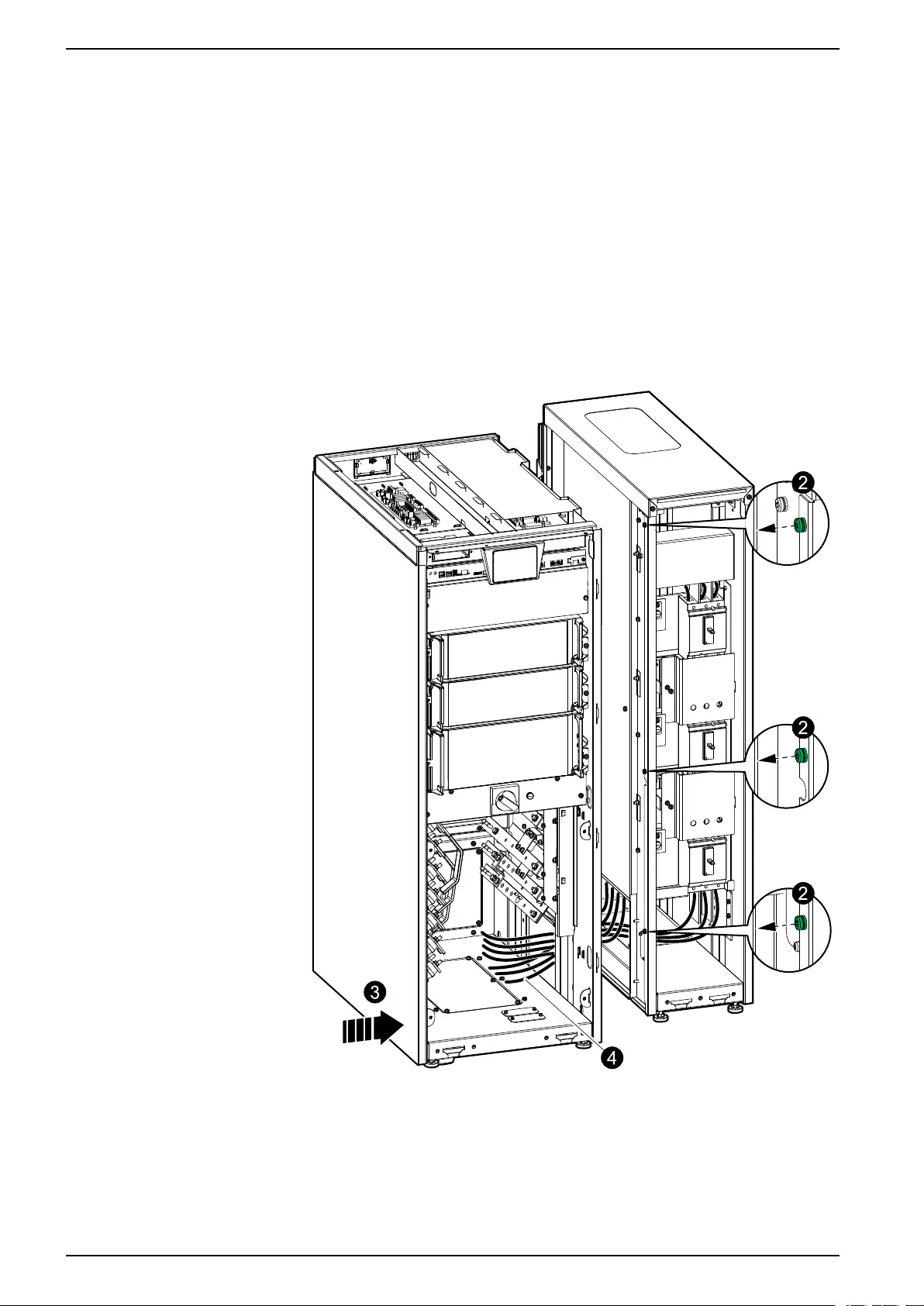
Maintenance Bypass Cabinet Interconnect the UPS and the Maintenance Bypass Cabinet
Interconnect the UPS and the Maintenance Bypass
Cabinet
1. Remove the transportation brackets from the maintenance bypass cabinet, if
not already removed for seismic anchoring.
2. Remove the three M6 x 16 mm interconnection screws from the left side of the
maintenance bypass cabinet. Save for interconnection.
3. Position the UPS close to the maintenance bypass cabinet with a little free
space between the cabinets.
4. Route the internal power cables from the maintenance bypass cabinet into the
UPS.
Front View of the UPS and the Maintenance Bypass Cabinet
42 990-5909-001
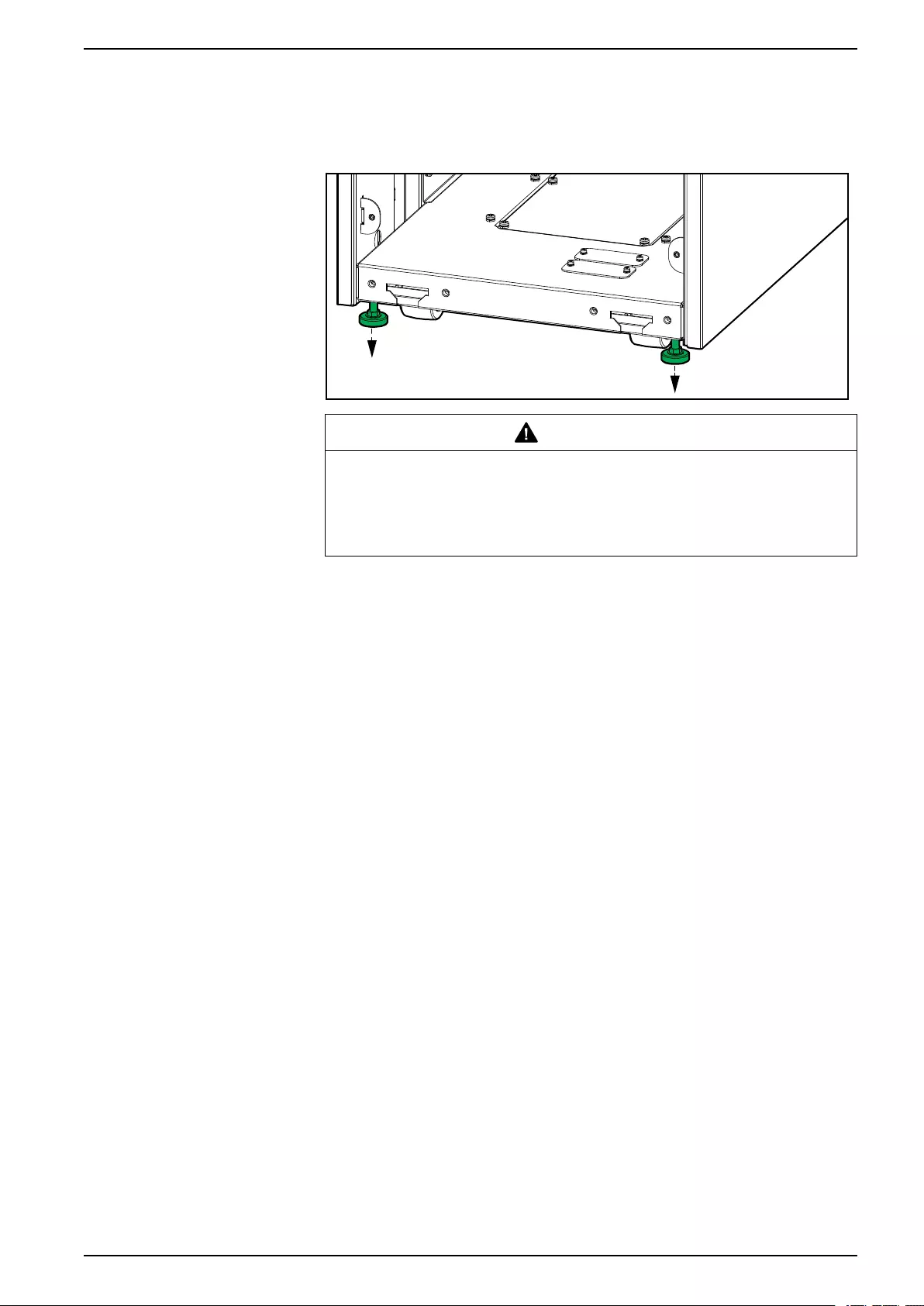
Interconnect the UPS and the Maintenance Bypass Cabinet Maintenance Bypass Cabinet
7. Lower the front and rear leveling feet on the UPS and the maintenance bypass
cabinet with a wrench until they connect with the floor. Use a bubble-leveler to
check that the UPS and maintenance bypass cabinet are level.
Front View of the UPS
CAUTION
TIP HAZARD
Do not move the cabinet after the leveling feet have been lowered.
Failure to follow these instructions can result in injury or equipment
damage.
990-5909-001 45
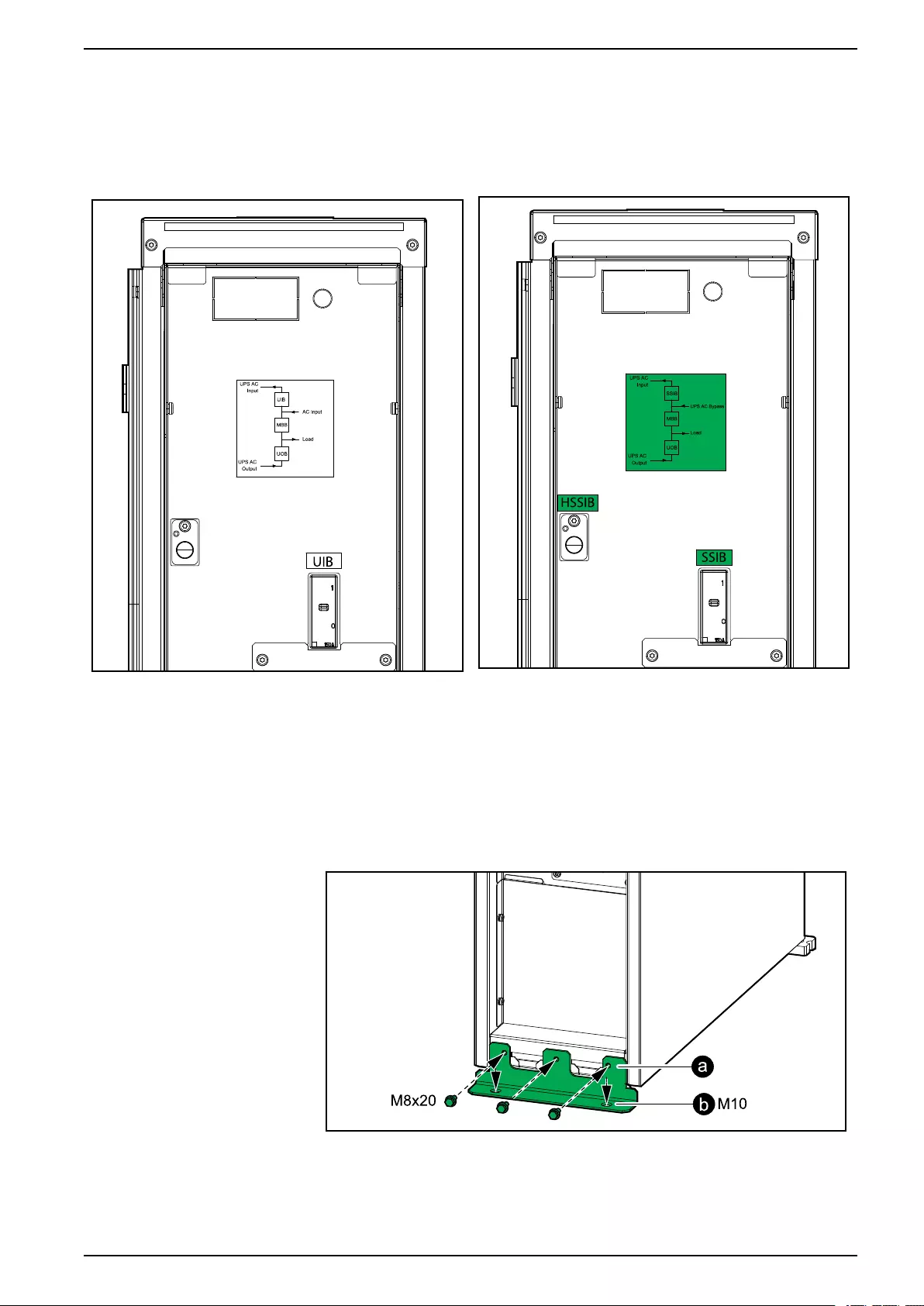
Final Installation Maintenance Bypass Cabinet
2. Only for dual mains: Add the labels SSIB, HSSIB, and the diagram label on
the upper front plate. The labels are provided with this manual.
Front View of the Maintenance Bypass Cabinet –
Single Mains
Front View of the Maintenance Bypass Cabinet –
Dual Mains
3. Only for seismic anchoring:
a. Install the seismic front anchoring bracket on the maintenance bypass
cabinet with the provided M8 bolts.
b. Mount the seismic front anchoring bracket on the maintenance bypass
cabinet to the floor with M10 expansion bolts (not provided).
Front View of the Maintenance Bypass Cabinet
990-5909-001 51
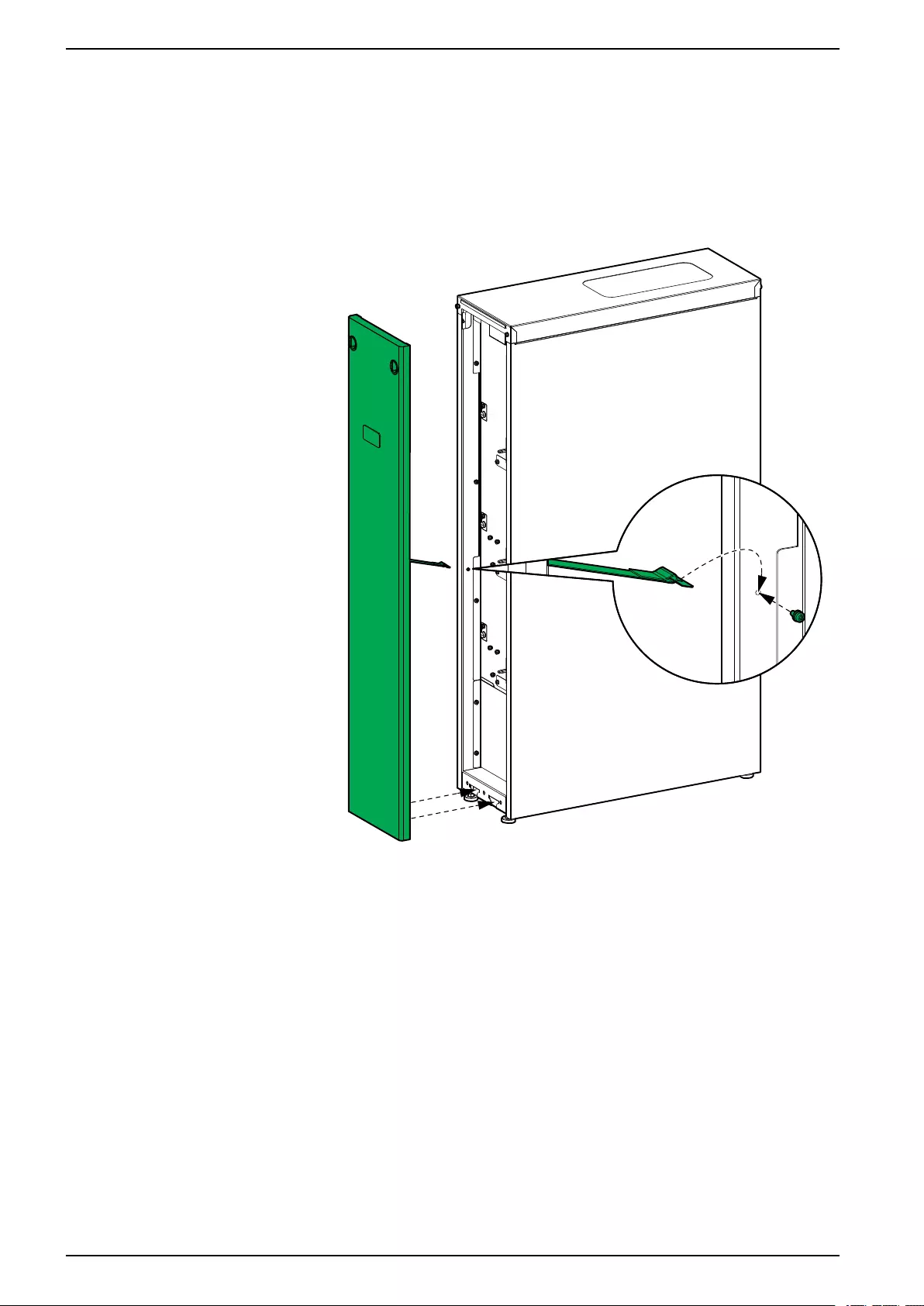
Maintenance Bypass Cabinet Final Installation
4. Reinstall the front panel on the maintenance bypass cabinet:
a. Insert the two taps in the bottom of the front panel in the maintenance
bypass cabinet at a tilted angle.
b. Reconnect the front panel strap to the maintenance bypass cabinet.
c. Close the front panel and lock with the two locking knobs.
Front Right View of the Maintenance Bypass Cabinet
5. Follow the UPS installation manual to connect the internal power cables in the
UPS.
52 990-5909-001




Schneider Electric
35 rue Joseph Monier
92500 Rueil Malmaison
France
+ 33 (0) 1 41 29 70 00
www.schneider-electric.com
As standards, specifications, and design change from time to time,
please ask for confirmation of the information given in this publication.
© 2018 – 2018 Schneider Electric. All rights reserved.
990-5909-001
